Site analysis
2 likes1,167 views
SITE ANALYSIS STREET OF JORDAN amazing , perfect but we didn`t complete it it has a lot of information
1 of 14
Downloaded 19 times



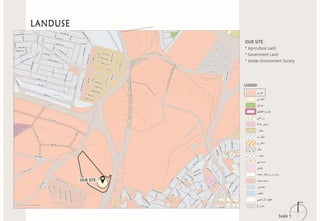
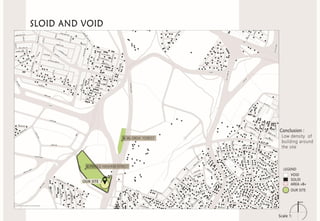
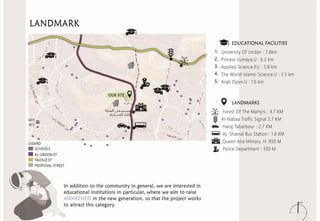
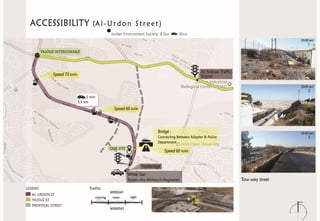
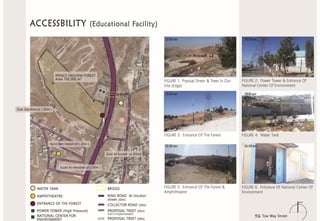
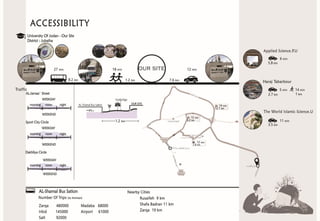
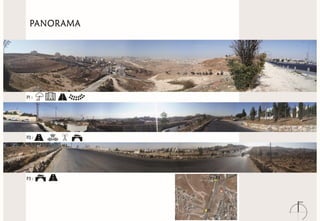
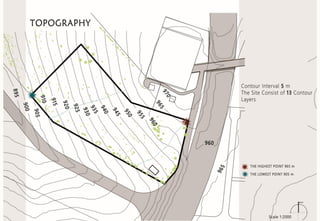
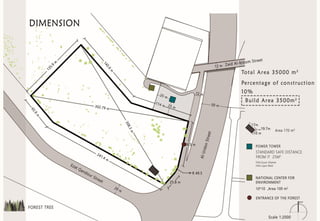
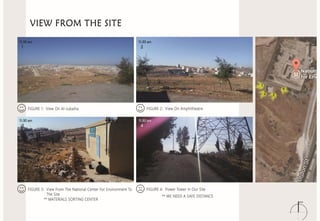

Ad
Recommended
Site Analysis
Site Analysis Khaled Almusa
╠²
The document outlines a proposal for a professional gymnasium at a university site, highlighting its strategic location near major streets and surrounded by evergreen trees. It discusses both opportunities and challenges, such as environmental concerns, potential customer limitations, and design considerations that incorporate passive cooling and sustainable practices. The project aims to enhance educational functions while providing commercial services to students and the community.06-Working details-cladding-Marble-by Prof Dr. Ehab Ezzat 2018
06-Working details-cladding-Marble-by Prof Dr. Ehab Ezzat 2018Faculty of fine arts -Cairo. Egypt.
╠²
This document provides details on installing stone cladding on buildings, including considerations for the stone properties, design loads, dimensional changes to the building, and height of panels. It recommends a minimum thickness of 20mm for hard stone panels like granite and marble below 3.7m high, increasing to 40mm thick above 3.7m high. For softer stones like limestone, the recommended minimum thickness is 50mm for panels below 3.7m and 75mm thick for panels above 3.7m. Proper specification of panel thickness depends on factors like processing equipment limitations and the type of fixing and anchoring system used.SIEMENS HQ
SIEMENS HQDennis Ramm
╠²
This document contains architectural drawings and plans for different levels of a proposed Siemens office building in Masdar City, Abu Dhabi. The drawings include floor plans showing the layouts and dimensions of rooms, common areas, mechanical areas and other building infrastructure. Dimensions, room labels and height information are provided on the drawings. Additional information includes areas of leasable and common spaces, drawing titles, scales, dates and revision details.Space design, circulation & service
Space design, circulation & serviceSami Sahli
╠²
ž¬ž¬┘垦┘ł┘ä ž¦┘ä┘łž½┘Ŗ┘éž® ž¬žĄ┘ģ┘Ŗ┘ģ ž¦┘ä┘ģž│ž¦ž▒žŁ ┘łž¦┘äž│┘Ŗ┘å┘ģž¦ž¬ ┘ł┘鞦ž╣ž¦ž¬ ž¦┘ä┘ģžżž¬┘ģž▒ž¦ž¬ ┘łž¦┘ä┘ģ┘āž¬ž©ž¦ž¬žī ┘ģž╣ ž¦┘䞬ž▒┘ā┘Ŗž▓ ž╣┘ä┘ē ž¦┘䞦ž╣ž¬ž©ž¦ž▒ž¦ž¬ ž¦┘ä┘ģž╣┘ģž¦ž▒┘Ŗž® ┘łž¦┘ä┘łžĖ┘Ŗ┘ü┘Ŗž® ┘äž«┘ä┘é ž©┘Ŗž”ž¦ž¬ ┘ģ┘䞦ž”┘ģž® ┘ä┘äž▓┘łž¦ž▒. ž¬ž┤┘ģ┘ä ž¦┘䞬žĄ┘ģ┘Ŗ┘ģž¦ž¬ ┘ģ┘ģž▒ž¦ž¬ ┘ģ┘垦ž│ž©ž®žī ┘ģž¬žĘ┘äž©ž¦ž¬ ž¦┘äž│┘䞦┘ģž®žī ž¬┘łž▓┘Ŗž╣ ž¦┘ä┘ģ┘鞦ž╣ž»žī ┘łž«žĄž¦ž”žĄ ž¦┘䞥┘łž¬ ┘äžźž╣žĘž¦žĪ ž¬ž¼ž▒ž©ž® ┘ģžŁž│┘åž® ┘ä┘äž¼┘ģ┘ć┘łž▒. ž©ž¦┘äžźžČž¦┘üž® žź┘ä┘ē ž░┘ä┘āžī ž¬ž¬┘垦┘ł┘ä ž¦┘ä┘łž½┘Ŗ┘éž® ž¬┘üž¦žĄ┘Ŗ┘ä žŁ┘ł┘ä ž¦┘ä┘ģž▒ž¦┘ü┘é ž¦┘äžźžČž¦┘ü┘Ŗž® ┘ģž½┘ä ž¦┘ä┘ģžĘž¦ž╣┘ģ ┘łž¦┘ä┘āž¦┘ü┘Ŗž¬ž▒┘Ŗž¦ž¬.Masdar city presentation
Masdar city presentationALzahraaMohammed5
╠²
Masdar City in Abu Dhabi aims to be one of the world's most sustainable cities. It combines traditional Arabic design principles with modern technologies to minimize energy usage. Some key strategies include urban layering to encourage walking, narrow streets and buildings clustered for shade, and wind towers to promote air flow. Renewable energy sources like solar power are also utilized. The city has received LEED certification and aims to achieve zero carbon emissions through its focus on sustainability and energy efficiency.Site Analysis Edward t. white
Site Analysis Edward t. whiteDania Abdel-aziz
╠²
This document discusses site diagramming as a tool for architectural design analysis. It emphasizes the importance of thoroughly analyzing a site's contextual information prior to beginning design concepts. Key site issues addressed through contextual analysis and diagramming include location, size, zoning, natural and man-made features, circulation, utilities, sensory qualities, and implications for human use and climate considerations. The document provides guidance on collecting relevant site data, developing diagrams to organize this information, and using diagrams to inform responsive architectural design solutions.Site Analysis
Site AnalysisKhaled Almusa
╠²
The project site in southern Abdoun is strategically positioned for visibility and accessibility, surrounded by a tranquil residential area and evergreen landscape, although it faces challenges like noise pollution from nearby streets and a significant slope. The design aims to create an aesthetically pleasing, green building that incorporates passive solar heating and cooling, as well as adherence to LEED standards, while addressing potential thermal comfort issues due to climate variations. Additional considerations include security measures, effective drainage, and sustainable waste management to enhance the overall environment for surrounding residents.žŻž│ž│ ž¬žĄ┘ģ┘Ŗ┘ģ ┘垦ž»┘Ŗ ž▒┘Ŗž¦žČ┘Ŗ - sport club design
žŻž│ž│ ž¬žĄ┘ģ┘Ŗ┘ģ ┘垦ž»┘Ŗ ž▒┘Ŗž¦žČ┘Ŗ - sport club designNadaElsaed
╠²
ž¦ž│ž│ ž¬žĄ┘ģ┘Ŗ┘ģ ┘垦ž»┘Ŗ ž▒┘Ŗž¦žČ┘Ŗ ž¦ž¼ž¬┘ģž¦ž╣┘ŖDesign of Sport Complex
Design of Sport Complexatchitect and design
╠²
The document outlines the design and construction plan for a sports complex at the Columbia Institute of Engineering and Technology in Raipur, which includes various facilities such as badminton courts, table tennis, a carrom hall, and a gym. It emphasizes the importance of proper planning, foundation types, and structural elements like columns, beams, and slabs in the construction process. The project has been successful and highlights the collaborative effort necessary for achieving such an initiative.FLOATING CITIES
FLOATING CITIES NihalIbraheem1
╠²
┘Ŗž¬┘垦┘ł┘ä ž¦┘ä┘ģž│ž¬┘åž» žŻž│ž│ ž¬žĄ┘ģ┘Ŗ┘ģ ž¦┘ä┘ģž©ž¦┘å┘Ŗžī ž«ž¦žĄž® ┘鞦ž╣ž¦ž¬ ž¦┘ä┘ģžżž¬┘ģž▒ž¦ž¬ ┘łž¦┘ä┘ģž¬ž¦žŁ┘üžī ┘ģž╣ ž¦┘䞬ž▒┘ā┘Ŗž▓ ž╣┘ä┘ē ž¦┘äž¼┘łž¦┘åž© ž¦┘ä┘łžĖ┘Ŗ┘ü┘Ŗž® ┘łž¦┘䞬┘łž▓┘Ŗž╣ ž¦┘ä┘ģ┘āž¦┘å┘Ŗ ┘äžČ┘ģž¦┘å ž▒ž¦žŁž® ž¦┘äž¼┘ģ┘ć┘łž▒. ┘ā┘ģž¦ ┘Ŗž»ž▒ž│ ž¦┘ä┘ģž»ž¦ž«┘ä ┘łž¦┘ä┘ģž«ž¦ž▒ž¼ ┘łžŻ┘ć┘ģ┘Ŗž® ž¦┘ä┘ģž│ž¦žŁž® ┘ü┘Ŗ ž¬┘åžĖ┘Ŗ┘ģ ž¦┘䞣ž▒┘āž® ž»ž¦ž«┘ä ž¦┘ä┘鞦ž╣ž®. ┘ŖžŻž¬┘Ŗ ž¦┘ä┘ģž│ž¬┘åž» ž©┘ģž╣┘ä┘ł┘ģž¦ž¬ ž¬┘üžĄ┘Ŗ┘ä┘Ŗž® žŁ┘ł┘ä ž¦┘äž╣┘垦žĄž▒ ž¦┘ä┘ģž╣┘ģž¦ž▒┘Ŗž® ┘łž¦┘䞬žĄ┘ģ┘Ŗ┘ģ┘Ŗž® ž¦┘ä┘䞦ž▓┘ģž® ┘äžČ┘ģž¦┘å ž¬┘üž¦ž╣┘ä žŻ┘üžČ┘ä ž©┘Ŗ┘å ž¦┘äž▓┘łž¦ž▒ ┘łž¦┘ä┘ģ┘āž¦┘å.abdali site analysis.pptx
abdali site analysis.pptxaseel
╠²
The document provides a site analysis for a design project located in Abdali, Amman, Jordan. It includes the following information:
1. A historical background of the Abdali district, noting its importance as the geographic center of Amman.
2. Details about the site location, surrounding landmarks, accessibility, topography, dimensions, and zoning classification.
3. An analysis of climate factors like temperature, radiation, sky cover and their implications for thermal comfort.
4. Information about circulation, noise levels, pollution, and existing services in the area.
The document concludes with shadows studies for winter and summer, an analysis of solid to void ratios, and sketches of the site plan.Checklist for working details and execution drawings
Checklist for working details and execution drawingsDr Walaa Yoseph
╠²
ž¦┘ä┘łž½┘Ŗ┘éž® ž¬žŁž¬┘ł┘Ŗ ž╣┘ä┘ē ž¬┘üž¦žĄ┘Ŗ┘ä ž¬žĄ┘ģ┘Ŗ┘ģ ž¦┘ä┘ģž┤ž▒┘łž╣ ┘łž¦┘ä┘ģž╣ž¦┘Ŗ┘Ŗž▒ ž¦┘ä┘ü┘å┘Ŗž® ž¦┘ä┘䞦ž▓┘ģž® ┘äžźž╣ž»ž¦ž» ┘ä┘łžŁž¦ž¬ ž¦┘äž▒ž│┘ģžī ž©ž»žĪ┘ŗž¦ ┘ģ┘å ž¦┘äž╣┘垦žĄž▒ ž¦┘ä┘ģž╣┘ģž¦ž▒┘Ŗž® ┘łž¦┘äžź┘åž┤ž¦ž”┘Ŗž® žź┘ä┘ē ž¦┘䞬┘łž▓┘Ŗž╣ ž¦┘ä┘łžĖ┘Ŗ┘ü┘Ŗ ┘ä┘ä┘ģž│ž¦žŁž¦ž¬. ž¬ž┤┘ģ┘ä ž¦┘äž©┘Ŗž¦┘垦ž¬ ┘ģž╣┘ä┘ł┘ģž¦ž¬ ž╣┘å ž¦┘ä┘ģž¦┘ä┘āžī ž¦┘䞦ž│ž¬ž┤ž¦ž▒┘Ŗ┘Ŗ┘åžī ┘łž¦┘äž©┘Ŗž¦┘垦ž¬ ž¦┘ä┘ü┘å┘Ŗž® ž¦┘䞯ž«ž▒┘ē ž¦┘ä┘ģžĘ┘ä┘łž©ž®. ┘ā┘ģž¦ ž¬┘łžČžŁ ┘ā┘Ŗ┘ü┘Ŗž® ž¬┘åžĖ┘Ŗ┘ģ ž¦┘ä┘ä┘łžŁž¦ž¬ ┘łž¬┘üž¦žĄ┘Ŗ┘ä┘枦žī ž©┘ģž¦ ┘ü┘Ŗ ž░┘ä┘ā ž¦┘ä┘ģž│ž¦┘éžĘ ┘łž¦┘ä┘éžĘž¦ž╣ž¦ž¬ ┘łž¦┘ä┘łž¦ž¼┘枦ž¬.ž©žŁž½ ž╣┘å ž¦┘ä┘ģž©ž¦┘å┘Ŗ ž¦┘äž½┘鞦┘ü┘Ŗž® ┘łž¦┘䞬ž▒┘ü┘Ŗ┘ć┘Ŗž® - ┘åžĖž▒┘Ŗž¦ž¬ ž╣┘ģž¦ž▒ž®1
ž©žŁž½ ž╣┘å ž¦┘ä┘ģž©ž¦┘å┘Ŗ ž¦┘äž½┘鞦┘ü┘Ŗž® ┘łž¦┘䞬ž▒┘ü┘Ŗ┘ć┘Ŗž® - ┘åžĖž▒┘Ŗž¦ž¬ ž╣┘ģž¦ž▒ž®1Ibrahem Qasim
╠²
ž¬ž¬┘垦┘ł┘ä ž¦┘ä┘łž½┘Ŗ┘éž® ž©žŁž½┘ŗž¦ ž╣┘å ž¦┘äž½┘鞦┘üž® ┘łž¦┘ä┘ģž╣┘ģž¦ž▒ ┘ü┘Ŗ ž¦┘ä┘ģžżž│ž│ž¦ž¬ ž¦┘䞬ž╣┘ä┘Ŗ┘ģ┘Ŗž®. ž¬ž▒┘āž▓ ž╣┘ä┘ē ž¬žĄ┘ģ┘Ŗ┘ģ ž¦┘ä┘ģž©ž¦┘å┘Ŗ ž¦┘䞬ž▒┘ü┘Ŗ┘ć┘Ŗž® ┘ü┘Ŗ ┘ā┘ä┘Ŗž¦ž¬ ž¦┘ä┘ć┘åž»ž│ž® ž¦┘ä┘ģž╣┘ģž¦ž▒┘Ŗž®. ž¬žŁž¬┘ł┘Ŗ ž╣┘ä┘ē ž©┘Ŗž¦┘垦ž¬ ž¬┘üžĄ┘Ŗ┘ä┘Ŗž® ┘łžŻž▒┘鞦┘ģ ž¬ž¬ž╣┘ä┘é ž©ž¦┘ä┘ģ┘łžČ┘łž╣.University
Universityfreemadoo
╠²
ž¬ž│ž¬ž╣ž▒žČ ž¦┘ä┘łž½┘Ŗ┘éž® ┘ģ┘鞬ž▒žŁž¦ž¬ ž¬žĄ┘ģ┘Ŗ┘ģž¦ž¬ ┘ģž╣┘ģž¦ž▒┘Ŗž® ┘ä┘ģž▒ž¦┘ü┘é ž¼ž¦┘ģž╣┘Ŗž® ┘ģž¬ž╣ž»ž»ž®žī ┘ģž╣ ž¬žŁ┘ä┘Ŗ┘ä ┘ģ┘ł┘éž╣ ž¦┘ä┘ģž┤ž▒┘łž╣ ┘ģ┘å žŁ┘Ŗž½ ž¦┘ä┘ģž▒ž¦┘ü┘é ž¦┘ä┘ģžŁ┘ŖžĘž® ┘łž¬ž«žĘ┘ŖžĘ┘ć ž¦┘äžźž»ž¦ž▒┘Ŗ. ž¬ž¬žČ┘ģ┘å ž¦┘ä┘łž½┘Ŗ┘éž® ┘ģž╣┘ä┘ł┘ģž¦ž¬ ž╣┘å ž¦┘äžĘž▒┘é ž¦┘ä┘ģžŁ┘ŖžĘž®žī ž¦┘ä┘ģž»ž¦ž«┘äžī ┘łž¦┘ä┘ģž╣ž¦┘Ŗ┘Ŗž▒ ž¦┘ä┘ģžĘ┘ä┘łž©ž® ┘ģ┘å ┘éž©┘ä ž¦┘ä┘ģž¼┘äž│ ž¦┘䞯ž╣┘ä┘ē ┘ä┘äž¼ž¦┘ģž╣ž¦ž¬žī ┘ā┘ģž¦ ž¬ž│ž¬ž╣ž▒žČ žŻ┘å┘ģž¦žĘ ž¦┘䞬žĄ┘ģ┘Ŗ┘ģ ž¦┘ä┘ģž«ž¬┘ä┘üž® ┘ł┘ā┘Ŗ┘ü┘Ŗž® ž¬┘łž▓┘Ŗž╣ ž¦┘ä┘üž▒ž¦ž║ž¦ž¬ ┘ü┘Ŗ ž¦┘ä┘ģž©ž¦┘å┘Ŗ ž¦┘äž¼ž¦┘ģž╣┘Ŗž®. ž¬┘ćž»┘ü ž¦┘äž╣ž▒┘łžČ žź┘ä┘ē ž¬┘éž»┘Ŗ┘ģ ž¬žĄ┘ģ┘Ŗ┘ģž¦ž¬ ┘üž╣ž¦┘äž® ž¬┘äž©┘Ŗ ž¦žŁž¬┘Ŗž¦ž¼ž¦ž¬ ž¦┘äžĘ┘䞦ž© ┘łž¬žČ┘ģ┘å ž│┘ć┘ł┘äž® ž¦┘䞣ž▒┘āž® ┘łž¦┘䞬┘łž¦žĄ┘ä ž»ž¦ž«┘ä ž¦┘䞣ž▒┘ģ ž¦┘äž¼ž¦┘ģž╣┘Ŗ.ž¦ž│ž│ ž¬ž«žĘ┘Ŗ┘Ć┘Ć┘ĆžĘ ž╣ž¦┘ģ ┘ä┘ģž»┘Ŗ┘åž® ž│┘ā┘å┘Ŗ┘Ć┘Ćž®
ž¦ž│ž│ ž¬ž«žĘ┘Ŗ┘Ć┘Ć┘ĆžĘ ž╣ž¦┘ģ ┘ä┘ģž»┘Ŗ┘åž® ž│┘ā┘å┘Ŗ┘Ć┘Ćž®Alamin Bhaa
╠²
ž¬ž¬┘垦┘ł┘ä ž¦┘ä┘łž½┘Ŗ┘éž® ┘ģ┘łžČ┘łž╣ ž¦┘䞬ž«žĘ┘ŖžĘ ž¦┘äž╣┘ģž▒ž¦┘å┘Ŗ ┘łžŻ┘ć┘ģ┘Ŗž¬┘ć ┘ü┘Ŗ ž¬┘åžĖ┘Ŗ┘ģ ž¦┘䞬ž¼┘ģž╣ž¦ž¬ ž¦┘äž│┘āž¦┘å┘Ŗž® ┘ä┘ģ┘łž¦ž¼┘ćž® ž¦┘䞬žŁž»┘Ŗž¦ž¬ ž¦┘䞦┘鞬žĄž¦ž»┘Ŗž® ┘łž¦┘䞦ž¼ž¬┘ģž¦ž╣┘Ŗž®. ┘ā┘ģž¦ ž¬ž▒┘āž▓ ž╣┘ä┘ē žČž▒┘łž▒ž® ž¦ž╣ž¬┘ģž¦ž» žŻž│ž│ ž╣┘ä┘ģ┘Ŗž® ┘ģž▒┘åž® ┘ü┘Ŗ ž╣┘ģ┘ä┘Ŗž® ž¦┘䞬ž«žĘ┘ŖžĘ ┘äžČ┘ģž¦┘å ž¬┘äž©┘Ŗž® ž¦žŁž¬┘Ŗž¦ž¼ž¦ž¬ ž¦┘ä┘ģž¼ž¬┘ģž╣ž¦ž¬ ┘łž¬┘łž▓┘Ŗž╣ ž¦┘ä┘ģ┘łž¦ž▒ž» ž©ž┤┘ā┘ä ž╣ž¦ž»┘ä. ž¦┘ä┘łž½┘Ŗ┘éž® ž¬ž¬žČ┘ģ┘å žŻ┘ŖžČ┘ŗž¦ ž»ž▒ž¦ž│ž® ž¦┘äž╣┘垦žĄž▒ ž¦┘ä┘ģž«ž¬┘ä┘üž® ┘ä┘䞬ž«žĘ┘ŖžĘ ┘łž¦┘䞬┘üž¦ž╣┘ä ž©┘Ŗ┘å ž¦┘ä┘ģž▒ž¦┘āž▓ ž¦┘äž╣┘ģž▒ž¦┘å┘Ŗž® ┘łž¦┘䞬┘łž▓┘Ŗž╣ ž¦┘äž¼ž║ž▒ž¦┘ü┘Ŗ.Zaha Hadid
Zaha Hadidillustriousdee
╠²
Zaha Hadid is an Iraqi-British architect known for her experimental deconstructivist style that pushes boundaries. She consistently creates visionary designs that intensify urban landscapes with flowing forms. Notable projects include the Vitra Fire Station in Germany, the Center for Contemporary Art in Cincinnati, and ephemeral pavilions for Chanel. Hadid was the first woman to win the Pritzker Architecture Prize and is renowned for redefining architecture and challenging traditional design.convention center litrature
convention center litratureSrujanaReddy41
╠²
This document provides information on the design of a convention center, including:
- A brief history of early convention centers dating back to the 15th century.
- Details on the typical spaces found in convention centers like meeting rooms, ballrooms, and exhibit halls.
- Considerations for the design such as zoning, circulation, accessibility, services, and parking.
- Standards for areas per person, hall capacities, and dimensions of spaces.
- The need to incorporate sustainability features like renewable energy use, green spaces, and waste management.ž¦ž│ž│ ž¬žĄ┘ģ┘Ŗ┘ģ ž¦┘äž¼ž¦┘ģž╣ž® ž¦┘䞦┘ć┘ä┘Ŗž®.pdf
ž¦ž│ž│ ž¬žĄ┘ģ┘Ŗ┘ģ ž¦┘äž¼ž¦┘ģž╣ž® ž¦┘䞦┘ć┘ä┘Ŗž®.pdfALAQBAHGDAD
╠²
┘Ŗž│ž¬ž╣ž▒žČ ┘ćž░ž¦ ž¦┘ä┘ģž┤ž▒┘łž╣ ž¦┘äž©žŁž½┘Ŗ ┘ü┘Ŗ ž¼ž¦┘ģž╣ž® ž╣┘Ŗ┘å ž┤┘ģž│ ž¬žĄ┘ģ┘Ŗ┘ģ ž¦┘ä┘ģž▒ž¦┘ü┘é ž¦┘䞯┘āž¦ž»┘Ŗ┘ģ┘Ŗž® ┘łž¦┘ä┘ć┘åž»ž│┘Ŗž® ┘ģž╣ ž¦┘䞬ž▒┘ā┘Ŗž▓ ž╣┘ä┘ē ž¦ž╣ž¬ž©ž¦ž▒ž¦ž¬ ž¦┘䞬žĄ┘ģ┘Ŗ┘ģ ž¦┘ä┘łžĖ┘Ŗ┘ü┘Ŗž® ┘ł┘ģž¬žĘ┘äž©ž¦ž¬ ž¦┘䞯┘ģž¦┘ā┘å ž¦┘ä┘ģž«ž¬┘ä┘üž® ┘ģž½┘ä ž¦┘ä┘üžĄ┘ł┘ä ž¦┘äž»ž▒ž¦ž│┘Ŗž®žī ž¦┘ä┘ģž╣ž¦┘ģ┘äžī ┘łž¦┘ä┘ģ┘āž¬ž©ž¦ž¬. ┘ā┘ģž¦ ┘Ŗž¬┘垦┘ł┘ä ž¦┘äž©žŁž½ žŻ┘ć┘ģ┘Ŗž® ž¦┘äž╣┘łž¦┘ģ┘ä ž¦┘äž©┘Ŗž”┘Ŗž® ┘łž¦┘䞣ž▒┘āž® ž¦┘äž│┘äž│ž® ž»ž¦ž«┘ä ž¦┘䞣ž▒┘ģ ž¦┘äž¼ž¦┘ģž╣┘Ŗ ┘äžČ┘ģž¦┘å ž▒ž¦žŁž® ž¦┘äžĘ┘䞦ž© ┘łžŻž╣žČž¦žĪ ┘ć┘Ŗž”ž® ž¦┘䞬ž»ž▒┘Ŗž│. ┘Ŗž¬┘ģ ž¬┘åžĖ┘Ŗ┘ģ ž¦┘äž©žŁž½ ┘ü┘Ŗ ┘üžĄ┘ł┘ä ┘ģž¬ž╣ž»ž»ž®žī ž©┘ģž¦ ┘ü┘Ŗ ž░┘ä┘ā ž¦┘äž»ž▒ž¦ž│ž® ž¦┘ä┘ģ┘Ŗž»ž¦┘å┘Ŗž® ┘łž¦┘䞬┘åžĖ┘Ŗ┘ģ ž¦┘ä┘ģ┘āž¦┘å┘Ŗ ┘ä┘ä┘ģ┘åž┤žóž¬ ž¦┘äž¼ž¦┘ģž╣┘Ŗž®.Lecture 7: Village architecture in Jordan
Lecture 7: Village architecture in JordanDania Abdel-aziz
╠²
The document describes the architecture of three traditional villages in Jordan - Hmud Village, Ma'in Village, and Um-El-Kunndom Village. It discusses the sites, buildings, construction materials, and design features of homes, churches, and other structures within the villages. The architecture represents the transition from semi-nomadic to agricultural lifestyles, and utilizes local stone like basalt and limestone in vernacular styles adapted to the natural environment.ž¦ž│ž│ ž¬žĄ┘ģ┘Ŗ┘ģ ┘łž¦žŁž® ž½┘鞦┘ü┘Ŗž®
ž¦ž│ž│ ž¬žĄ┘ģ┘Ŗ┘ģ ┘łž¦žŁž® ž½┘鞦┘ü┘Ŗž®nada khaled
╠²
┘Ŗž¬┘垦┘ł┘ä ž¦┘ä┘łž½┘Ŗ┘éž® ┘łžĄ┘ü ┘ģž┤ž▒┘łž╣ ž┤ž¦┘ģ┘ä ┘Ŗž¬┘ā┘ł┘å ┘ģ┘å ž╣ž»ž® ž╣┘垦žĄž▒ ž¬ž┤┘ģ┘ä ž¦┘䞬ž▒┘ü┘Ŗ┘ć ┘łž¦┘äž½┘鞦┘üž® ┘łž¦┘äž│┘ā┘å ┘łž¦┘äž«ž»┘ģž¦ž¬žī ┘ģž╣ ž¦┘䞬ž▒┘ā┘Ŗž▓ ž╣┘ä┘ē ž¬žĄ┘ģ┘Ŗ┘ģ ž¦┘ä┘ģ┘ł┘éž╣ ┘łž¦┘䞬žŁ┘ä┘Ŗ┘ä ž¦┘äž╣ž¦┘ģ ┘ä┘ć. ┘Ŗž©ž▒ž▓ ž¦┘ä┘ģž┤ž▒┘łž╣ žŻ┘ć┘ģ┘Ŗž® ž¦┘äž©┘Ŗž”ž® ž¦┘ä┘ģžŁ┘ŖžĘž® ┘łž¦┘äž╣┘łž¦┘ģ┘ä ž¦┘ä┘ģžżž½ž▒ž® ┘ü┘Ŗ ┘ā┘ä ┘ģž▒žŁ┘äž® ┘ģ┘å ┘ģž▒ž¦žŁ┘ä ž¦┘䞬žŁ┘ä┘Ŗ┘ä ┘äžČ┘ģž¦┘å ž¬žŁ┘é┘Ŗ┘é žŻ┘ćž»ž¦┘ü ž¦┘䞬žĄ┘ģ┘Ŗ┘ģ. ┘ā┘ģž¦ ┘Ŗ┘垦┘éž┤ ž¦┘ä┘łž½┘Ŗ┘éž® žŻ┘ŖžČ┘ŗž¦ žŻ┘å┘łž¦ž╣ ž¦┘ä┘ģž│ž¦ž▒žŁ ┘łž¦┘ä┘ģ┘ģ┘Ŗž▓ž¦ž¬ ┘łž¦┘äž╣┘Ŗ┘łž© ž¦┘äž«ž¦žĄž® ž©┘ā┘ä ┘ģ┘å┘枦žī ┘ģž╣ ž¦┘䞬ž▒┘ā┘Ŗž▓ ž╣┘ä┘ē žŻ┘ć┘ģ┘Ŗž® ž¦┘䞬žĄ┘ģ┘Ŗ┘ģ ┘ü┘Ŗ žź┘åž┤ž¦žĪ ž©┘Ŗž”ž® ┘ģ┘䞦ž”┘ģž®.Site analysis check list
Site analysis check listNicky Wong
╠²
This document provides a checklist for analyzing a site in Bukit Bintang, Kuala Lumpur including its location details, existing context, accessibility, surroundings, views, weather effects, nearby buildings, surfaces, drainage, and a selected building's function, layout, design, history, and architectural elements. The checklist covers general site facts, access, the five senses, circulation, vegetation, sunlight direction, weather, building context, heritage areas, listed buildings, site levels, and drainage to thoroughly understand the site.ž«žĘ┘łž¦ž¬ ž▒ž│┘ģ ┘ģž│ž¦┘éžĘ ž¦┘äž│┘䞦┘ä┘ģ -stairs 2.pdf
ž«žĘ┘łž¦ž¬ ž▒ž│┘ģ ┘ģž│ž¦┘éžĘ ž¦┘äž│┘䞦┘ä┘ģ -stairs 2.pdfOlfat abd elghany helwa
╠²
ž¬ž¬┘垦┘ł┘ä ž¦┘ä┘łž½┘Ŗ┘éž® ž«žĘ┘łž¦ž¬ ž▒ž│┘ģ ž¦┘ä┘ģž│ž¦┘éžĘ ž¦┘䞯┘ü┘é┘Ŗ┘æž®žī ┘ģž╣ ž¦┘䞬ž▒┘ā┘Ŗž▓ ž╣┘ä┘ē ž¬┘łžČ┘ŖžŁ ž¦┘ä┘ģžŁž¦┘łž▒žī ž¦┘䞯ž©ž╣ž¦ž»žī ┘łžĘž▒┘é ž▒ž│┘ģ ž¦┘äž╣┘垦žĄž▒ ž¦┘ä┘ģž╣┘ģž¦ž▒┘Ŗž® ┘āž¦┘äž│┘䞦┘ä┘ģ ┘łž¦┘䞯ž│žĘžŁ. ž¬ž┤┘ģ┘ä ž¦┘ä┘łž½┘Ŗ┘éž® žŻ┘ŖžČ┘ŗž¦ ž¬┘üž¦žĄ┘Ŗ┘ä žŁ┘ł┘ä ž¦ž│ž¬ž«ž»ž¦┘ģ ž«žĘ┘łžĘ ┘ģž¬┘éžĘž╣ž® ┘ł┘ģž│ž¬┘ģž▒ž® ┘䞬┘ģž½┘Ŗ┘ä ž¦┘ä┘ģž│ž¦┘üž¦ž¬ ┘łž¦┘äž╣┘䞦┘鞦ž¬ ž©┘Ŗ┘å ┘ģž«ž¬┘ä┘ü ž¦┘äž╣┘垦žĄž▒. ┘ā┘ģž¦ ž¬┘Åž┤┘Ŗž▒ žź┘ä┘ē žŻ┘ć┘ģ┘Ŗž® ┘ģž▒ž¦ž╣ž¦ž® ž¦┘ä┘üž▒┘ł┘é ž©┘Ŗ┘å ž¦┘äž▒ž│┘ł┘ģž¦ž¬ ┘ü┘Ŗ ┘ģž│ž¬┘ł┘Ŗž¦ž¬ ┘ģž¬ž╣ž»ž»ž®.Motel Research case study
Motel Research case studyRwanEsmail1
╠²
ž¦┘ä┘łž½┘Ŗ┘éž® ž¬ž¬┘垦┘ł┘ä ž»ž▒ž¦ž│ž® žŁž¦┘äž® ┘äž½┘䞦ž½ž® ┘ģ┘łž¬┘Ŗ┘䞦ž¬ ┘ł┘ü┘åž»┘é ┘ü┘Ŗ ┘ģž╣ž¦┘Ŗ┘Ŗž▒ ž¬žĄ┘ģ┘Ŗ┘ģ ┘łž¬ž┤ž║┘Ŗ┘ä ┘ćž░┘ć ž¦┘ä┘ģ┘åž┤žóž¬. ž¦┘䞬ž▒┘ā┘Ŗž▓ ž╣┘ä┘ē ┘ģž╣ž¦┘Ŗ┘Ŗž▒ ž¦┘䞬žĄ┘ģ┘Ŗ┘ģ ž¦┘ä┘ģž╣┘ģž¦ž▒┘Ŗ ┘łž¦┘䞬ž«žĘ┘ŖžĘ┘Ŗž®žī ┘łž¬┘ł┘ü┘Ŗž▒ ┘łž│ž¦ž”┘ä ž¦┘äž▒ž¦žŁž® ┘ä┘äžČ┘Ŗ┘ł┘ü ┘ć┘ł ž¦┘äž¼ž▓žĪ ž¦┘䞯ž│ž¦ž│┘Ŗ ┘ģ┘å ž¦┘äž»ž▒ž¦ž│ž®. ž¦┘ä┘łž½┘Ŗ┘éž® ž¬ž©ž▒ž▓ žŻ┘ŖžČž¦┘ŗ žŻ┘ć┘ģ┘Ŗž® ž¦┘䞬┘åž│┘Ŗ┘é ┘ģž╣ ž¦┘äž©┘Ŗž”ž® ž¦┘ä┘ģžŁ┘ŖžĘž® ┘ł┘äž«žĄž¦ž”žĄ ž¦┘ä┘ģ┘ł┘éž╣ ┘ü┘Ŗ ž¦ž«ž¬┘Ŗž¦ž▒ ž¦┘ä┘ģ┘łž¦┘éž╣ ž¦┘ä┘ģ┘垦ž│ž©ž® ┘ä┘ćž░┘ć ž¦┘ä┘ģ┘åž┤žóž¬.Graduation Thesis
Graduation ThesisShafiya Rizwan
╠²
The document outlines a feasibility study for an athlete rehabilitation center in the United Arab Emirates, emphasizing the growing demand due to a high population of athletes and a significant number of individuals with health issues like obesity and diabetes. It discusses the importance of effective facility design, key features of rehabilitation services, and strategic site selection in cities like Abu Dhabi and Dubai, highlighting their respective advantages. The study reveals an emerging lucrative market for rehabilitation services driven by government initiatives and the increasing interest in sports within the region.Exhibition design - ž¬žĄ┘ģ┘Ŗ┘ģ ┘ģž╣ž▒žČ
Exhibition design - ž¬žĄ┘ģ┘Ŗ┘ģ ┘ģž╣ž▒žČNadaElsaed
╠²
┘Ŗž¬┘垦┘ł┘ä ┘ćž░ž¦ ž¦┘äž©žŁž½ ž¬žĄ┘ģ┘Ŗ┘ģ ž¦┘ä┘ģž╣ž¦ž▒žČ ┘ł┘Ŗž»ž▒ž│ ž¦┘äž╣┘垦žĄž▒ ž¦┘䞯ž│ž¦ž│┘Ŗž® ž¦┘ä┘ģž¬ž╣┘ä┘éž® ž©ž¬┘łž▓┘Ŗž╣ ž¦┘ä┘ģž│ž¦žŁž¦ž¬ ┘łž¬žŁ┘é┘Ŗ┘é ž¦┘äž╣┘䞦┘鞦ž¬ ž¦┘ä┘łžĖ┘Ŗ┘ü┘Ŗž® ž¦┘ä┘ģ┘垦ž│ž©ž®. ┘Ŗž¬žĘž▒┘é žŻ┘ŖžČ┘ŗž¦ žź┘ä┘ē žŻ┘ć┘ģ┘Ŗž® ž¦┘ä┘ģž»ž¦ž«┘ä ┘łž¦┘ä┘ģž«ž¦ž▒ž¼ ┘łž¬┘å┘łž╣ ž¦┘ä┘ģž│ž¦žŁž¦ž¬ ┘äžČ┘ģž¦┘å ž│┘ć┘ł┘äž® ž¦┘䞣ž▒┘āž® ┘łž¦┘䞬ž¼ž▒ž©ž® ž¦┘äžź┘Ŗž¼ž¦ž©┘Ŗž® ┘ä┘äž▓┘łž¦ž▒žī ž©ž¦┘äžźžČž¦┘üž® žź┘ä┘ē ž¦ž│ž¬ž«ž»ž¦┘ģ ž¦┘äžČ┘łžĪžī ž¦┘䞯┘ä┘łž¦┘åžī ┘łž¦┘ä┘ģ┘é┘Ŗž¦ž│ ┘ü┘Ŗ ž¦┘䞬žĄ┘ģ┘Ŗ┘ģ ž¦┘äž»ž¦ž«┘ä┘Ŗ. ┘ā┘ģž¦ ┘Ŗž¬┘ģ ž¦┘䞬žŻ┘ā┘Ŗž» ž╣┘ä┘ē žČž▒┘łž▒ž® ž¬žĄ┘ģ┘Ŗ┘ģ ž¦┘ä┘ģž│ž¦žŁž¦ž¬ ┘䞬┘ā┘ł┘å ┘ģž▒┘åž® ┘łž¼ž░ž¦ž©ž® ┘ģž╣ žŻž«ž░ žĘž©┘Ŗž╣ž® ž¦┘ä┘ģž╣ž▒┘łžČž¦ž¬ ┘łž¦┘äž¼┘ģ┘ć┘łž▒ ž¦┘ä┘ģž│ž¬┘ćž»┘ü ž©ž╣┘Ŗ┘å ž¦┘䞦ž╣ž¬ž©ž¦ž▒.Lecture 12 : Al-salt City
Lecture 12 : Al-salt CityDania Abdel-aziz
╠²
┘ģž»┘Ŗ┘åž® ž¦┘äž│┘äžĘ ┘ü┘Ŗ ž¦┘䞯ž▒ž»┘å ž¬┘éž╣ ž╣┘ä┘ē ž¦ž▒ž¬┘üž¦ž╣ ┘Ŗž¬ž▒ž¦┘łžŁ ž©┘Ŗ┘å 790 ┘ł 1100 ┘ģž¬ž▒ ┘ü┘ł┘é ž│žĘžŁ ž¦┘äž©žŁž▒žī ┘łž¬ž©ž╣ž» žŁ┘łž¦┘ä┘Ŗ 30 ┘ā┘Ŗ┘ä┘ł┘ģž¬ž▒ ž╣┘å ž╣┘ģž¦┘å. ž¬ž¦ž▒┘Ŗž«┘枦 ┘Ŗ┘ģž¬ž» ┘ģ┘åž░ ž¦┘äž╣žĄ┘łž▒ ž¦┘ä┘Ŗ┘ł┘垦┘å┘Ŗž® ┘łž¦┘äž▒┘ł┘ģž¦┘å┘Ŗž®žī ┘ł┘éž» ž┤┘ćž»ž¬ ž¦┘äž╣ž»┘Ŗž» ┘ģ┘å ž¦┘ä┘üž¬ž▒ž¦ž¬ ž¦┘䞬ž¦ž▒┘Ŗž«┘Ŗž® ž©┘ģž¦ ┘ü┘Ŗ ž░┘ä┘ā ž¦┘äž╣žĄ┘łž▒ ž¦┘䞯┘Ŗ┘łž©┘Ŗž® ┘łž¦┘ä┘ģ┘ģ┘ä┘ł┘ā┘Ŗž® ┘łž¦┘äž╣ž½┘ģž¦┘å┘Ŗž®. ž¦┘ä┘Ŗ┘ł┘ģžī ž¬žŁž¬┘üžĖ ž¦┘äž│┘äžĘ ž©ž¬ž▒ž¦ž½ ž║┘å┘Ŗ ┘ł┘ģž╣ž¦┘ä┘ģ ž¬ž¦ž▒┘Ŗž«┘Ŗž® ž┤┘ć┘Ŗž▒ž® ┘ģž½┘ä ž¦┘ä┘é┘äž╣ž® ┘łž¦┘ä┘ā┘垦ž”ž│ ž¦┘ä┘éž»┘Ŗ┘ģž®.ž¦┘ä┘ģž«žĘžĘ-ž¦┘äžźž│ž¬ž▒ž¦ž¬┘Ŗž¼┘ē-┘äžź┘é┘ä┘Ŗ┘ģ-ž¼┘å┘łž©-ž¦┘䞥ž╣┘Ŗž».▒Ķ╗Õ┤┌
ž¦┘ä┘ģž«žĘžĘ-ž¦┘äžźž│ž¬ž▒ž¦ž¬┘Ŗž¼┘ē-┘äžź┘é┘ä┘Ŗ┘ģ-ž¼┘å┘łž©-ž¦┘䞥ž╣┘Ŗž».▒Ķ╗Õ┤┌AhmedAwad3237
╠²
┘Ŗž¬┘垦┘ł┘ä ž¦┘ä┘ģž│ž¬┘åž» ž¦ž│ž¬ž╣ž▒ž¦žČ┘ŗž¦ ┘äžź┘é┘ä┘Ŗ┘ģ ž¼┘å┘łž© ž¦┘䞥ž╣┘Ŗž» ┘ü┘Ŗ ┘ģžĄž▒žī ┘ģž┤┘Ŗž▒┘ŗž¦ žź┘ä┘ē žŻ┘ć┘ģ┘Ŗž¬┘ć ž¦┘䞦ž│ž¬ž▒ž¦ž¬┘Ŗž¼┘Ŗž® ┘łž¦┘䞦┘鞬žĄž¦ž»┘Ŗž® ┘ā┘ł┘å┘ć ž©┘łž¦ž©ž® ┘ä┘äž▒ž©žĘ ž©┘Ŗ┘å ┘ģžĄž▒ ┘łž»┘ł┘ä žź┘üž▒┘Ŗ┘é┘Ŗž¦ ┘łžóž│┘Ŗž¦. ┘ā┘ģž¦ ┘Ŗž│┘äžĘ ž¦┘äžČ┘łžĪ ž╣┘ä┘ē ž¦┘䞬žŁž»┘Ŗž¦ž¬ ž¦┘䞬┘å┘ģ┘ł┘Ŗž® ž¦┘䞬┘Ŗ ┘Ŗ┘łž¦ž¼┘ć┘枦 ž¦┘äžź┘é┘ä┘Ŗ┘ģ ž©┘ģž¦ ┘ü┘Ŗ ž░┘ä┘ā ┘åž│ž© ž¦┘äž©žĘž¦┘äž® ž¦┘äž╣ž¦┘ä┘Ŗž® ┘łž¦┘䞣ž¦ž¼ž® žź┘ä┘ē ž¼ž░ž© ž¦┘äž│┘āž¦┘å ┘䞬ž«┘ü┘Ŗ┘ü ž¦┘ä┘āž½ž¦┘üž¦ž¬ ┘ü┘Ŗ ┘ģ┘垦žĘ┘é ž¦┘äž»┘䞬ž¦žī ┘ł┘Ŗ┘鞬ž▒žŁ ž¦ž│ž¬ž▒ž¦ž¬┘Ŗž¼┘Ŗž¦ž¬ ┘䞬žŁ┘é┘Ŗ┘é ž¦┘䞬┘å┘ģ┘Ŗž® ž¦┘ä┘ģž│ž¬ž»ž¦┘ģž® ┘łž¦┘äž▒┘üž╣ ┘ģ┘å ┘ģž│ž¬┘ł┘ē ž¦┘ä┘ģž╣┘Ŗž┤ž®.Birth of modernity Adolf Loos
Birth of modernity Adolf LoosSandra Draskovic
╠²
The document provides background information on Adolf Loos and his critiques of ornamentation and Gesamtkunstwerk. It summarizes that Loos returned to Vienna in 1896 after time in America and was critical of the conservative Viennese architecture and the Secessionist movement. Loos published "Ornament and Crime" in 1908 to elaborate on his view that the Secessionists' use of ornament had no cultural relevance. The document then provides examples of Loos' architectural works from the early 20th century that demonstrated his purist style without ornament, including the Caf├® Museum, Goldman & Salatsch store, and Kartner American Bar in Vienna.analysis and our concept
analysis and our concept Najdat Hazaimh
╠²
This document discusses the strengths, weaknesses, opportunities, and threats for the areas of Zarqa and Amman, along with a vision for a sustainable urban neighborhood. The key points are:
- Strengths include connections between areas and open/agricultural spaces, while weaknesses include proximity to industrial areas and pollution.
- Opportunities involve utilizing quarries and abandoned areas for industries and jobs, while threats include expansion increasing population density and pollution.
- The vision is to build a sustainable city that meets current needs without compromising the future, including goals of sustainable transportation, preserving open spaces, and enhancing quarries for income and development.Amman development-corridor (g8)
Amman development-corridor (g8)Najdat Hazaimh
╠²
ž¬┘垦┘éž┤ ž¦┘ä┘łž½┘Ŗ┘éž® ž¦┘äž©┘Ŗž¦┘垦ž¬ ž¦┘äž©┘Ŗž”┘Ŗž® ┘łž¬žŻž½┘Ŗž▒ž¦ž¬ ž¦┘䞬┘å┘ģ┘Ŗž® ┘ü┘Ŗ ┘ģ┘åžĘ┘éž® ž¦┘äž▓ž▒┘鞦žĪžī ž©┘ģž¦ ┘ü┘Ŗ ž░┘ä┘ā ž¬┘łž▓┘Ŗž╣ ž¦┘䞯ž▒ž¦žČ┘Ŗ ┘łž¦ž│ž¬ž«ž»ž¦┘ģž¦ž¬┘枦. ┘ā┘ģž¦ ┘Ŗž¬┘ģ ž¬ž│┘ä┘ŖžĘ ž¦┘äžČ┘łžĪ ž╣┘ä┘ē ┘ģž┤ž¦┘ā┘ä ž¦┘äž©┘Ŗž”ž® ┘ģž½┘ä ž¦┘䞬┘ä┘łž½ ž¦┘ä┘垦ž¬ž¼ ž╣┘å ž¦┘䞯┘åž┤žĘž® ž¦┘䞥┘垦ž╣┘Ŗž® ┘łž¦┘ä┘āž│ž¦ž▒ž¦ž¬žī ž©ž¦┘äžźžČž¦┘üž® žź┘ä┘ē žČž╣┘ü ┘ü┘Ŗ ž¦┘äž©┘å┘Ŗž® ž¦┘䞬žŁž¬┘Ŗž® ┘łž¬┘ćž»┘Ŗž»ž¦ž¬ ž¦┘ä┘ģ┘łž¦ž▒ž» ž¦┘ä┘ģž¦ž”┘Ŗž®. ž¬ž┤┘Ŗž▒ ž¦┘ä┘垬ž¦ž”ž¼ žź┘ä┘ē žŻ┘ć┘ģ┘Ŗž® ž¦┘䞬┘åž│┘Ŗ┘é ž©┘Ŗ┘å ž¦┘äž¼┘枦ž¬ ž¦┘ä┘ģž╣┘å┘Ŗž® ┘ä┘ģž╣ž¦┘äž¼ž® ž¦┘ä┘éžČž¦┘Ŗž¦ ž¦┘äž©┘Ŗž”┘Ŗž® ┘łž¦┘䞦ž¼ž¬┘ģž¦ž╣┘Ŗž®.More Related Content
What's hot (20)
Design of Sport Complex
Design of Sport Complexatchitect and design
╠²
The document outlines the design and construction plan for a sports complex at the Columbia Institute of Engineering and Technology in Raipur, which includes various facilities such as badminton courts, table tennis, a carrom hall, and a gym. It emphasizes the importance of proper planning, foundation types, and structural elements like columns, beams, and slabs in the construction process. The project has been successful and highlights the collaborative effort necessary for achieving such an initiative.FLOATING CITIES
FLOATING CITIES NihalIbraheem1
╠²
┘Ŗž¬┘垦┘ł┘ä ž¦┘ä┘ģž│ž¬┘åž» žŻž│ž│ ž¬žĄ┘ģ┘Ŗ┘ģ ž¦┘ä┘ģž©ž¦┘å┘Ŗžī ž«ž¦žĄž® ┘鞦ž╣ž¦ž¬ ž¦┘ä┘ģžżž¬┘ģž▒ž¦ž¬ ┘łž¦┘ä┘ģž¬ž¦žŁ┘üžī ┘ģž╣ ž¦┘䞬ž▒┘ā┘Ŗž▓ ž╣┘ä┘ē ž¦┘äž¼┘łž¦┘åž© ž¦┘ä┘łžĖ┘Ŗ┘ü┘Ŗž® ┘łž¦┘䞬┘łž▓┘Ŗž╣ ž¦┘ä┘ģ┘āž¦┘å┘Ŗ ┘äžČ┘ģž¦┘å ž▒ž¦žŁž® ž¦┘äž¼┘ģ┘ć┘łž▒. ┘ā┘ģž¦ ┘Ŗž»ž▒ž│ ž¦┘ä┘ģž»ž¦ž«┘ä ┘łž¦┘ä┘ģž«ž¦ž▒ž¼ ┘łžŻ┘ć┘ģ┘Ŗž® ž¦┘ä┘ģž│ž¦žŁž® ┘ü┘Ŗ ž¬┘åžĖ┘Ŗ┘ģ ž¦┘䞣ž▒┘āž® ž»ž¦ž«┘ä ž¦┘ä┘鞦ž╣ž®. ┘ŖžŻž¬┘Ŗ ž¦┘ä┘ģž│ž¬┘åž» ž©┘ģž╣┘ä┘ł┘ģž¦ž¬ ž¬┘üžĄ┘Ŗ┘ä┘Ŗž® žŁ┘ł┘ä ž¦┘äž╣┘垦žĄž▒ ž¦┘ä┘ģž╣┘ģž¦ž▒┘Ŗž® ┘łž¦┘䞬žĄ┘ģ┘Ŗ┘ģ┘Ŗž® ž¦┘ä┘䞦ž▓┘ģž® ┘äžČ┘ģž¦┘å ž¬┘üž¦ž╣┘ä žŻ┘üžČ┘ä ž©┘Ŗ┘å ž¦┘äž▓┘łž¦ž▒ ┘łž¦┘ä┘ģ┘āž¦┘å.abdali site analysis.pptx
abdali site analysis.pptxaseel
╠²
The document provides a site analysis for a design project located in Abdali, Amman, Jordan. It includes the following information:
1. A historical background of the Abdali district, noting its importance as the geographic center of Amman.
2. Details about the site location, surrounding landmarks, accessibility, topography, dimensions, and zoning classification.
3. An analysis of climate factors like temperature, radiation, sky cover and their implications for thermal comfort.
4. Information about circulation, noise levels, pollution, and existing services in the area.
The document concludes with shadows studies for winter and summer, an analysis of solid to void ratios, and sketches of the site plan.Checklist for working details and execution drawings
Checklist for working details and execution drawingsDr Walaa Yoseph
╠²
ž¦┘ä┘łž½┘Ŗ┘éž® ž¬žŁž¬┘ł┘Ŗ ž╣┘ä┘ē ž¬┘üž¦žĄ┘Ŗ┘ä ž¬žĄ┘ģ┘Ŗ┘ģ ž¦┘ä┘ģž┤ž▒┘łž╣ ┘łž¦┘ä┘ģž╣ž¦┘Ŗ┘Ŗž▒ ž¦┘ä┘ü┘å┘Ŗž® ž¦┘ä┘䞦ž▓┘ģž® ┘äžźž╣ž»ž¦ž» ┘ä┘łžŁž¦ž¬ ž¦┘äž▒ž│┘ģžī ž©ž»žĪ┘ŗž¦ ┘ģ┘å ž¦┘äž╣┘垦žĄž▒ ž¦┘ä┘ģž╣┘ģž¦ž▒┘Ŗž® ┘łž¦┘äžź┘åž┤ž¦ž”┘Ŗž® žź┘ä┘ē ž¦┘䞬┘łž▓┘Ŗž╣ ž¦┘ä┘łžĖ┘Ŗ┘ü┘Ŗ ┘ä┘ä┘ģž│ž¦žŁž¦ž¬. ž¬ž┤┘ģ┘ä ž¦┘äž©┘Ŗž¦┘垦ž¬ ┘ģž╣┘ä┘ł┘ģž¦ž¬ ž╣┘å ž¦┘ä┘ģž¦┘ä┘āžī ž¦┘䞦ž│ž¬ž┤ž¦ž▒┘Ŗ┘Ŗ┘åžī ┘łž¦┘äž©┘Ŗž¦┘垦ž¬ ž¦┘ä┘ü┘å┘Ŗž® ž¦┘䞯ž«ž▒┘ē ž¦┘ä┘ģžĘ┘ä┘łž©ž®. ┘ā┘ģž¦ ž¬┘łžČžŁ ┘ā┘Ŗ┘ü┘Ŗž® ž¬┘åžĖ┘Ŗ┘ģ ž¦┘ä┘ä┘łžŁž¦ž¬ ┘łž¬┘üž¦žĄ┘Ŗ┘ä┘枦žī ž©┘ģž¦ ┘ü┘Ŗ ž░┘ä┘ā ž¦┘ä┘ģž│ž¦┘éžĘ ┘łž¦┘ä┘éžĘž¦ž╣ž¦ž¬ ┘łž¦┘ä┘łž¦ž¼┘枦ž¬.ž©žŁž½ ž╣┘å ž¦┘ä┘ģž©ž¦┘å┘Ŗ ž¦┘äž½┘鞦┘ü┘Ŗž® ┘łž¦┘䞬ž▒┘ü┘Ŗ┘ć┘Ŗž® - ┘åžĖž▒┘Ŗž¦ž¬ ž╣┘ģž¦ž▒ž®1
ž©žŁž½ ž╣┘å ž¦┘ä┘ģž©ž¦┘å┘Ŗ ž¦┘äž½┘鞦┘ü┘Ŗž® ┘łž¦┘䞬ž▒┘ü┘Ŗ┘ć┘Ŗž® - ┘åžĖž▒┘Ŗž¦ž¬ ž╣┘ģž¦ž▒ž®1Ibrahem Qasim
╠²
ž¬ž¬┘垦┘ł┘ä ž¦┘ä┘łž½┘Ŗ┘éž® ž©žŁž½┘ŗž¦ ž╣┘å ž¦┘äž½┘鞦┘üž® ┘łž¦┘ä┘ģž╣┘ģž¦ž▒ ┘ü┘Ŗ ž¦┘ä┘ģžżž│ž│ž¦ž¬ ž¦┘䞬ž╣┘ä┘Ŗ┘ģ┘Ŗž®. ž¬ž▒┘āž▓ ž╣┘ä┘ē ž¬žĄ┘ģ┘Ŗ┘ģ ž¦┘ä┘ģž©ž¦┘å┘Ŗ ž¦┘䞬ž▒┘ü┘Ŗ┘ć┘Ŗž® ┘ü┘Ŗ ┘ā┘ä┘Ŗž¦ž¬ ž¦┘ä┘ć┘åž»ž│ž® ž¦┘ä┘ģž╣┘ģž¦ž▒┘Ŗž®. ž¬žŁž¬┘ł┘Ŗ ž╣┘ä┘ē ž©┘Ŗž¦┘垦ž¬ ž¬┘üžĄ┘Ŗ┘ä┘Ŗž® ┘łžŻž▒┘鞦┘ģ ž¬ž¬ž╣┘ä┘é ž©ž¦┘ä┘ģ┘łžČ┘łž╣.University
Universityfreemadoo
╠²
ž¬ž│ž¬ž╣ž▒žČ ž¦┘ä┘łž½┘Ŗ┘éž® ┘ģ┘鞬ž▒žŁž¦ž¬ ž¬žĄ┘ģ┘Ŗ┘ģž¦ž¬ ┘ģž╣┘ģž¦ž▒┘Ŗž® ┘ä┘ģž▒ž¦┘ü┘é ž¼ž¦┘ģž╣┘Ŗž® ┘ģž¬ž╣ž»ž»ž®žī ┘ģž╣ ž¬žŁ┘ä┘Ŗ┘ä ┘ģ┘ł┘éž╣ ž¦┘ä┘ģž┤ž▒┘łž╣ ┘ģ┘å žŁ┘Ŗž½ ž¦┘ä┘ģž▒ž¦┘ü┘é ž¦┘ä┘ģžŁ┘ŖžĘž® ┘łž¬ž«žĘ┘ŖžĘ┘ć ž¦┘äžźž»ž¦ž▒┘Ŗ. ž¬ž¬žČ┘ģ┘å ž¦┘ä┘łž½┘Ŗ┘éž® ┘ģž╣┘ä┘ł┘ģž¦ž¬ ž╣┘å ž¦┘äžĘž▒┘é ž¦┘ä┘ģžŁ┘ŖžĘž®žī ž¦┘ä┘ģž»ž¦ž«┘äžī ┘łž¦┘ä┘ģž╣ž¦┘Ŗ┘Ŗž▒ ž¦┘ä┘ģžĘ┘ä┘łž©ž® ┘ģ┘å ┘éž©┘ä ž¦┘ä┘ģž¼┘äž│ ž¦┘䞯ž╣┘ä┘ē ┘ä┘äž¼ž¦┘ģž╣ž¦ž¬žī ┘ā┘ģž¦ ž¬ž│ž¬ž╣ž▒žČ žŻ┘å┘ģž¦žĘ ž¦┘䞬žĄ┘ģ┘Ŗ┘ģ ž¦┘ä┘ģž«ž¬┘ä┘üž® ┘ł┘ā┘Ŗ┘ü┘Ŗž® ž¬┘łž▓┘Ŗž╣ ž¦┘ä┘üž▒ž¦ž║ž¦ž¬ ┘ü┘Ŗ ž¦┘ä┘ģž©ž¦┘å┘Ŗ ž¦┘äž¼ž¦┘ģž╣┘Ŗž®. ž¬┘ćž»┘ü ž¦┘äž╣ž▒┘łžČ žź┘ä┘ē ž¬┘éž»┘Ŗ┘ģ ž¬žĄ┘ģ┘Ŗ┘ģž¦ž¬ ┘üž╣ž¦┘äž® ž¬┘äž©┘Ŗ ž¦žŁž¬┘Ŗž¦ž¼ž¦ž¬ ž¦┘äžĘ┘䞦ž© ┘łž¬žČ┘ģ┘å ž│┘ć┘ł┘äž® ž¦┘䞣ž▒┘āž® ┘łž¦┘䞬┘łž¦žĄ┘ä ž»ž¦ž«┘ä ž¦┘䞣ž▒┘ģ ž¦┘äž¼ž¦┘ģž╣┘Ŗ.ž¦ž│ž│ ž¬ž«žĘ┘Ŗ┘Ć┘Ć┘ĆžĘ ž╣ž¦┘ģ ┘ä┘ģž»┘Ŗ┘åž® ž│┘ā┘å┘Ŗ┘Ć┘Ćž®
ž¦ž│ž│ ž¬ž«žĘ┘Ŗ┘Ć┘Ć┘ĆžĘ ž╣ž¦┘ģ ┘ä┘ģž»┘Ŗ┘åž® ž│┘ā┘å┘Ŗ┘Ć┘Ćž®Alamin Bhaa
╠²
ž¬ž¬┘垦┘ł┘ä ž¦┘ä┘łž½┘Ŗ┘éž® ┘ģ┘łžČ┘łž╣ ž¦┘䞬ž«žĘ┘ŖžĘ ž¦┘äž╣┘ģž▒ž¦┘å┘Ŗ ┘łžŻ┘ć┘ģ┘Ŗž¬┘ć ┘ü┘Ŗ ž¬┘åžĖ┘Ŗ┘ģ ž¦┘䞬ž¼┘ģž╣ž¦ž¬ ž¦┘äž│┘āž¦┘å┘Ŗž® ┘ä┘ģ┘łž¦ž¼┘ćž® ž¦┘䞬žŁž»┘Ŗž¦ž¬ ž¦┘䞦┘鞬žĄž¦ž»┘Ŗž® ┘łž¦┘䞦ž¼ž¬┘ģž¦ž╣┘Ŗž®. ┘ā┘ģž¦ ž¬ž▒┘āž▓ ž╣┘ä┘ē žČž▒┘łž▒ž® ž¦ž╣ž¬┘ģž¦ž» žŻž│ž│ ž╣┘ä┘ģ┘Ŗž® ┘ģž▒┘åž® ┘ü┘Ŗ ž╣┘ģ┘ä┘Ŗž® ž¦┘䞬ž«žĘ┘ŖžĘ ┘äžČ┘ģž¦┘å ž¬┘äž©┘Ŗž® ž¦žŁž¬┘Ŗž¦ž¼ž¦ž¬ ž¦┘ä┘ģž¼ž¬┘ģž╣ž¦ž¬ ┘łž¬┘łž▓┘Ŗž╣ ž¦┘ä┘ģ┘łž¦ž▒ž» ž©ž┤┘ā┘ä ž╣ž¦ž»┘ä. ž¦┘ä┘łž½┘Ŗ┘éž® ž¬ž¬žČ┘ģ┘å žŻ┘ŖžČ┘ŗž¦ ž»ž▒ž¦ž│ž® ž¦┘äž╣┘垦žĄž▒ ž¦┘ä┘ģž«ž¬┘ä┘üž® ┘ä┘䞬ž«žĘ┘ŖžĘ ┘łž¦┘䞬┘üž¦ž╣┘ä ž©┘Ŗ┘å ž¦┘ä┘ģž▒ž¦┘āž▓ ž¦┘äž╣┘ģž▒ž¦┘å┘Ŗž® ┘łž¦┘䞬┘łž▓┘Ŗž╣ ž¦┘äž¼ž║ž▒ž¦┘ü┘Ŗ.Zaha Hadid
Zaha Hadidillustriousdee
╠²
Zaha Hadid is an Iraqi-British architect known for her experimental deconstructivist style that pushes boundaries. She consistently creates visionary designs that intensify urban landscapes with flowing forms. Notable projects include the Vitra Fire Station in Germany, the Center for Contemporary Art in Cincinnati, and ephemeral pavilions for Chanel. Hadid was the first woman to win the Pritzker Architecture Prize and is renowned for redefining architecture and challenging traditional design.convention center litrature
convention center litratureSrujanaReddy41
╠²
This document provides information on the design of a convention center, including:
- A brief history of early convention centers dating back to the 15th century.
- Details on the typical spaces found in convention centers like meeting rooms, ballrooms, and exhibit halls.
- Considerations for the design such as zoning, circulation, accessibility, services, and parking.
- Standards for areas per person, hall capacities, and dimensions of spaces.
- The need to incorporate sustainability features like renewable energy use, green spaces, and waste management.ž¦ž│ž│ ž¬žĄ┘ģ┘Ŗ┘ģ ž¦┘äž¼ž¦┘ģž╣ž® ž¦┘䞦┘ć┘ä┘Ŗž®.pdf
ž¦ž│ž│ ž¬žĄ┘ģ┘Ŗ┘ģ ž¦┘äž¼ž¦┘ģž╣ž® ž¦┘䞦┘ć┘ä┘Ŗž®.pdfALAQBAHGDAD
╠²
┘Ŗž│ž¬ž╣ž▒žČ ┘ćž░ž¦ ž¦┘ä┘ģž┤ž▒┘łž╣ ž¦┘äž©žŁž½┘Ŗ ┘ü┘Ŗ ž¼ž¦┘ģž╣ž® ž╣┘Ŗ┘å ž┤┘ģž│ ž¬žĄ┘ģ┘Ŗ┘ģ ž¦┘ä┘ģž▒ž¦┘ü┘é ž¦┘䞯┘āž¦ž»┘Ŗ┘ģ┘Ŗž® ┘łž¦┘ä┘ć┘åž»ž│┘Ŗž® ┘ģž╣ ž¦┘䞬ž▒┘ā┘Ŗž▓ ž╣┘ä┘ē ž¦ž╣ž¬ž©ž¦ž▒ž¦ž¬ ž¦┘䞬žĄ┘ģ┘Ŗ┘ģ ž¦┘ä┘łžĖ┘Ŗ┘ü┘Ŗž® ┘ł┘ģž¬žĘ┘äž©ž¦ž¬ ž¦┘䞯┘ģž¦┘ā┘å ž¦┘ä┘ģž«ž¬┘ä┘üž® ┘ģž½┘ä ž¦┘ä┘üžĄ┘ł┘ä ž¦┘äž»ž▒ž¦ž│┘Ŗž®žī ž¦┘ä┘ģž╣ž¦┘ģ┘äžī ┘łž¦┘ä┘ģ┘āž¬ž©ž¦ž¬. ┘ā┘ģž¦ ┘Ŗž¬┘垦┘ł┘ä ž¦┘äž©žŁž½ žŻ┘ć┘ģ┘Ŗž® ž¦┘äž╣┘łž¦┘ģ┘ä ž¦┘äž©┘Ŗž”┘Ŗž® ┘łž¦┘䞣ž▒┘āž® ž¦┘äž│┘äž│ž® ž»ž¦ž«┘ä ž¦┘䞣ž▒┘ģ ž¦┘äž¼ž¦┘ģž╣┘Ŗ ┘äžČ┘ģž¦┘å ž▒ž¦žŁž® ž¦┘äžĘ┘䞦ž© ┘łžŻž╣žČž¦žĪ ┘ć┘Ŗž”ž® ž¦┘䞬ž»ž▒┘Ŗž│. ┘Ŗž¬┘ģ ž¬┘åžĖ┘Ŗ┘ģ ž¦┘äž©žŁž½ ┘ü┘Ŗ ┘üžĄ┘ł┘ä ┘ģž¬ž╣ž»ž»ž®žī ž©┘ģž¦ ┘ü┘Ŗ ž░┘ä┘ā ž¦┘äž»ž▒ž¦ž│ž® ž¦┘ä┘ģ┘Ŗž»ž¦┘å┘Ŗž® ┘łž¦┘䞬┘åžĖ┘Ŗ┘ģ ž¦┘ä┘ģ┘āž¦┘å┘Ŗ ┘ä┘ä┘ģ┘åž┤žóž¬ ž¦┘äž¼ž¦┘ģž╣┘Ŗž®.Lecture 7: Village architecture in Jordan
Lecture 7: Village architecture in JordanDania Abdel-aziz
╠²
The document describes the architecture of three traditional villages in Jordan - Hmud Village, Ma'in Village, and Um-El-Kunndom Village. It discusses the sites, buildings, construction materials, and design features of homes, churches, and other structures within the villages. The architecture represents the transition from semi-nomadic to agricultural lifestyles, and utilizes local stone like basalt and limestone in vernacular styles adapted to the natural environment.ž¦ž│ž│ ž¬žĄ┘ģ┘Ŗ┘ģ ┘łž¦žŁž® ž½┘鞦┘ü┘Ŗž®
ž¦ž│ž│ ž¬žĄ┘ģ┘Ŗ┘ģ ┘łž¦žŁž® ž½┘鞦┘ü┘Ŗž®nada khaled
╠²
┘Ŗž¬┘垦┘ł┘ä ž¦┘ä┘łž½┘Ŗ┘éž® ┘łžĄ┘ü ┘ģž┤ž▒┘łž╣ ž┤ž¦┘ģ┘ä ┘Ŗž¬┘ā┘ł┘å ┘ģ┘å ž╣ž»ž® ž╣┘垦žĄž▒ ž¬ž┤┘ģ┘ä ž¦┘䞬ž▒┘ü┘Ŗ┘ć ┘łž¦┘äž½┘鞦┘üž® ┘łž¦┘äž│┘ā┘å ┘łž¦┘äž«ž»┘ģž¦ž¬žī ┘ģž╣ ž¦┘䞬ž▒┘ā┘Ŗž▓ ž╣┘ä┘ē ž¬žĄ┘ģ┘Ŗ┘ģ ž¦┘ä┘ģ┘ł┘éž╣ ┘łž¦┘䞬žŁ┘ä┘Ŗ┘ä ž¦┘äž╣ž¦┘ģ ┘ä┘ć. ┘Ŗž©ž▒ž▓ ž¦┘ä┘ģž┤ž▒┘łž╣ žŻ┘ć┘ģ┘Ŗž® ž¦┘äž©┘Ŗž”ž® ž¦┘ä┘ģžŁ┘ŖžĘž® ┘łž¦┘äž╣┘łž¦┘ģ┘ä ž¦┘ä┘ģžżž½ž▒ž® ┘ü┘Ŗ ┘ā┘ä ┘ģž▒žŁ┘äž® ┘ģ┘å ┘ģž▒ž¦žŁ┘ä ž¦┘䞬žŁ┘ä┘Ŗ┘ä ┘äžČ┘ģž¦┘å ž¬žŁ┘é┘Ŗ┘é žŻ┘ćž»ž¦┘ü ž¦┘䞬žĄ┘ģ┘Ŗ┘ģ. ┘ā┘ģž¦ ┘Ŗ┘垦┘éž┤ ž¦┘ä┘łž½┘Ŗ┘éž® žŻ┘ŖžČ┘ŗž¦ žŻ┘å┘łž¦ž╣ ž¦┘ä┘ģž│ž¦ž▒žŁ ┘łž¦┘ä┘ģ┘ģ┘Ŗž▓ž¦ž¬ ┘łž¦┘äž╣┘Ŗ┘łž© ž¦┘äž«ž¦žĄž® ž©┘ā┘ä ┘ģ┘å┘枦žī ┘ģž╣ ž¦┘䞬ž▒┘ā┘Ŗž▓ ž╣┘ä┘ē žŻ┘ć┘ģ┘Ŗž® ž¦┘䞬žĄ┘ģ┘Ŗ┘ģ ┘ü┘Ŗ žź┘åž┤ž¦žĪ ž©┘Ŗž”ž® ┘ģ┘䞦ž”┘ģž®.Site analysis check list
Site analysis check listNicky Wong
╠²
This document provides a checklist for analyzing a site in Bukit Bintang, Kuala Lumpur including its location details, existing context, accessibility, surroundings, views, weather effects, nearby buildings, surfaces, drainage, and a selected building's function, layout, design, history, and architectural elements. The checklist covers general site facts, access, the five senses, circulation, vegetation, sunlight direction, weather, building context, heritage areas, listed buildings, site levels, and drainage to thoroughly understand the site.ž«žĘ┘łž¦ž¬ ž▒ž│┘ģ ┘ģž│ž¦┘éžĘ ž¦┘äž│┘䞦┘ä┘ģ -stairs 2.pdf
ž«žĘ┘łž¦ž¬ ž▒ž│┘ģ ┘ģž│ž¦┘éžĘ ž¦┘äž│┘䞦┘ä┘ģ -stairs 2.pdfOlfat abd elghany helwa
╠²
ž¬ž¬┘垦┘ł┘ä ž¦┘ä┘łž½┘Ŗ┘éž® ž«žĘ┘łž¦ž¬ ž▒ž│┘ģ ž¦┘ä┘ģž│ž¦┘éžĘ ž¦┘䞯┘ü┘é┘Ŗ┘æž®žī ┘ģž╣ ž¦┘䞬ž▒┘ā┘Ŗž▓ ž╣┘ä┘ē ž¬┘łžČ┘ŖžŁ ž¦┘ä┘ģžŁž¦┘łž▒žī ž¦┘䞯ž©ž╣ž¦ž»žī ┘łžĘž▒┘é ž▒ž│┘ģ ž¦┘äž╣┘垦žĄž▒ ž¦┘ä┘ģž╣┘ģž¦ž▒┘Ŗž® ┘āž¦┘äž│┘䞦┘ä┘ģ ┘łž¦┘䞯ž│žĘžŁ. ž¬ž┤┘ģ┘ä ž¦┘ä┘łž½┘Ŗ┘éž® žŻ┘ŖžČ┘ŗž¦ ž¬┘üž¦žĄ┘Ŗ┘ä žŁ┘ł┘ä ž¦ž│ž¬ž«ž»ž¦┘ģ ž«žĘ┘łžĘ ┘ģž¬┘éžĘž╣ž® ┘ł┘ģž│ž¬┘ģž▒ž® ┘䞬┘ģž½┘Ŗ┘ä ž¦┘ä┘ģž│ž¦┘üž¦ž¬ ┘łž¦┘äž╣┘䞦┘鞦ž¬ ž©┘Ŗ┘å ┘ģž«ž¬┘ä┘ü ž¦┘äž╣┘垦žĄž▒. ┘ā┘ģž¦ ž¬┘Åž┤┘Ŗž▒ žź┘ä┘ē žŻ┘ć┘ģ┘Ŗž® ┘ģž▒ž¦ž╣ž¦ž® ž¦┘ä┘üž▒┘ł┘é ž©┘Ŗ┘å ž¦┘äž▒ž│┘ł┘ģž¦ž¬ ┘ü┘Ŗ ┘ģž│ž¬┘ł┘Ŗž¦ž¬ ┘ģž¬ž╣ž»ž»ž®.Motel Research case study
Motel Research case studyRwanEsmail1
╠²
ž¦┘ä┘łž½┘Ŗ┘éž® ž¬ž¬┘垦┘ł┘ä ž»ž▒ž¦ž│ž® žŁž¦┘äž® ┘äž½┘䞦ž½ž® ┘ģ┘łž¬┘Ŗ┘䞦ž¬ ┘ł┘ü┘åž»┘é ┘ü┘Ŗ ┘ģž╣ž¦┘Ŗ┘Ŗž▒ ž¬žĄ┘ģ┘Ŗ┘ģ ┘łž¬ž┤ž║┘Ŗ┘ä ┘ćž░┘ć ž¦┘ä┘ģ┘åž┤žóž¬. ž¦┘䞬ž▒┘ā┘Ŗž▓ ž╣┘ä┘ē ┘ģž╣ž¦┘Ŗ┘Ŗž▒ ž¦┘䞬žĄ┘ģ┘Ŗ┘ģ ž¦┘ä┘ģž╣┘ģž¦ž▒┘Ŗ ┘łž¦┘䞬ž«žĘ┘ŖžĘ┘Ŗž®žī ┘łž¬┘ł┘ü┘Ŗž▒ ┘łž│ž¦ž”┘ä ž¦┘äž▒ž¦žŁž® ┘ä┘äžČ┘Ŗ┘ł┘ü ┘ć┘ł ž¦┘äž¼ž▓žĪ ž¦┘䞯ž│ž¦ž│┘Ŗ ┘ģ┘å ž¦┘äž»ž▒ž¦ž│ž®. ž¦┘ä┘łž½┘Ŗ┘éž® ž¬ž©ž▒ž▓ žŻ┘ŖžČž¦┘ŗ žŻ┘ć┘ģ┘Ŗž® ž¦┘䞬┘åž│┘Ŗ┘é ┘ģž╣ ž¦┘äž©┘Ŗž”ž® ž¦┘ä┘ģžŁ┘ŖžĘž® ┘ł┘äž«žĄž¦ž”žĄ ž¦┘ä┘ģ┘ł┘éž╣ ┘ü┘Ŗ ž¦ž«ž¬┘Ŗž¦ž▒ ž¦┘ä┘ģ┘łž¦┘éž╣ ž¦┘ä┘ģ┘垦ž│ž©ž® ┘ä┘ćž░┘ć ž¦┘ä┘ģ┘åž┤žóž¬.Graduation Thesis
Graduation ThesisShafiya Rizwan
╠²
The document outlines a feasibility study for an athlete rehabilitation center in the United Arab Emirates, emphasizing the growing demand due to a high population of athletes and a significant number of individuals with health issues like obesity and diabetes. It discusses the importance of effective facility design, key features of rehabilitation services, and strategic site selection in cities like Abu Dhabi and Dubai, highlighting their respective advantages. The study reveals an emerging lucrative market for rehabilitation services driven by government initiatives and the increasing interest in sports within the region.Exhibition design - ž¬žĄ┘ģ┘Ŗ┘ģ ┘ģž╣ž▒žČ
Exhibition design - ž¬žĄ┘ģ┘Ŗ┘ģ ┘ģž╣ž▒žČNadaElsaed
╠²
┘Ŗž¬┘垦┘ł┘ä ┘ćž░ž¦ ž¦┘äž©žŁž½ ž¬žĄ┘ģ┘Ŗ┘ģ ž¦┘ä┘ģž╣ž¦ž▒žČ ┘ł┘Ŗž»ž▒ž│ ž¦┘äž╣┘垦žĄž▒ ž¦┘䞯ž│ž¦ž│┘Ŗž® ž¦┘ä┘ģž¬ž╣┘ä┘éž® ž©ž¬┘łž▓┘Ŗž╣ ž¦┘ä┘ģž│ž¦žŁž¦ž¬ ┘łž¬žŁ┘é┘Ŗ┘é ž¦┘äž╣┘䞦┘鞦ž¬ ž¦┘ä┘łžĖ┘Ŗ┘ü┘Ŗž® ž¦┘ä┘ģ┘垦ž│ž©ž®. ┘Ŗž¬žĘž▒┘é žŻ┘ŖžČ┘ŗž¦ žź┘ä┘ē žŻ┘ć┘ģ┘Ŗž® ž¦┘ä┘ģž»ž¦ž«┘ä ┘łž¦┘ä┘ģž«ž¦ž▒ž¼ ┘łž¬┘å┘łž╣ ž¦┘ä┘ģž│ž¦žŁž¦ž¬ ┘äžČ┘ģž¦┘å ž│┘ć┘ł┘äž® ž¦┘䞣ž▒┘āž® ┘łž¦┘䞬ž¼ž▒ž©ž® ž¦┘äžź┘Ŗž¼ž¦ž©┘Ŗž® ┘ä┘äž▓┘łž¦ž▒žī ž©ž¦┘äžźžČž¦┘üž® žź┘ä┘ē ž¦ž│ž¬ž«ž»ž¦┘ģ ž¦┘äžČ┘łžĪžī ž¦┘䞯┘ä┘łž¦┘åžī ┘łž¦┘ä┘ģ┘é┘Ŗž¦ž│ ┘ü┘Ŗ ž¦┘䞬žĄ┘ģ┘Ŗ┘ģ ž¦┘äž»ž¦ž«┘ä┘Ŗ. ┘ā┘ģž¦ ┘Ŗž¬┘ģ ž¦┘䞬žŻ┘ā┘Ŗž» ž╣┘ä┘ē žČž▒┘łž▒ž® ž¬žĄ┘ģ┘Ŗ┘ģ ž¦┘ä┘ģž│ž¦žŁž¦ž¬ ┘䞬┘ā┘ł┘å ┘ģž▒┘åž® ┘łž¼ž░ž¦ž©ž® ┘ģž╣ žŻž«ž░ žĘž©┘Ŗž╣ž® ž¦┘ä┘ģž╣ž▒┘łžČž¦ž¬ ┘łž¦┘äž¼┘ģ┘ć┘łž▒ ž¦┘ä┘ģž│ž¬┘ćž»┘ü ž©ž╣┘Ŗ┘å ž¦┘䞦ž╣ž¬ž©ž¦ž▒.Lecture 12 : Al-salt City
Lecture 12 : Al-salt CityDania Abdel-aziz
╠²
┘ģž»┘Ŗ┘åž® ž¦┘äž│┘äžĘ ┘ü┘Ŗ ž¦┘䞯ž▒ž»┘å ž¬┘éž╣ ž╣┘ä┘ē ž¦ž▒ž¬┘üž¦ž╣ ┘Ŗž¬ž▒ž¦┘łžŁ ž©┘Ŗ┘å 790 ┘ł 1100 ┘ģž¬ž▒ ┘ü┘ł┘é ž│žĘžŁ ž¦┘äž©žŁž▒žī ┘łž¬ž©ž╣ž» žŁ┘łž¦┘ä┘Ŗ 30 ┘ā┘Ŗ┘ä┘ł┘ģž¬ž▒ ž╣┘å ž╣┘ģž¦┘å. ž¬ž¦ž▒┘Ŗž«┘枦 ┘Ŗ┘ģž¬ž» ┘ģ┘åž░ ž¦┘äž╣žĄ┘łž▒ ž¦┘ä┘Ŗ┘ł┘垦┘å┘Ŗž® ┘łž¦┘äž▒┘ł┘ģž¦┘å┘Ŗž®žī ┘ł┘éž» ž┤┘ćž»ž¬ ž¦┘äž╣ž»┘Ŗž» ┘ģ┘å ž¦┘ä┘üž¬ž▒ž¦ž¬ ž¦┘䞬ž¦ž▒┘Ŗž«┘Ŗž® ž©┘ģž¦ ┘ü┘Ŗ ž░┘ä┘ā ž¦┘äž╣žĄ┘łž▒ ž¦┘䞯┘Ŗ┘łž©┘Ŗž® ┘łž¦┘ä┘ģ┘ģ┘ä┘ł┘ā┘Ŗž® ┘łž¦┘äž╣ž½┘ģž¦┘å┘Ŗž®. ž¦┘ä┘Ŗ┘ł┘ģžī ž¬žŁž¬┘üžĖ ž¦┘äž│┘äžĘ ž©ž¬ž▒ž¦ž½ ž║┘å┘Ŗ ┘ł┘ģž╣ž¦┘ä┘ģ ž¬ž¦ž▒┘Ŗž«┘Ŗž® ž┤┘ć┘Ŗž▒ž® ┘ģž½┘ä ž¦┘ä┘é┘äž╣ž® ┘łž¦┘ä┘ā┘垦ž”ž│ ž¦┘ä┘éž»┘Ŗ┘ģž®.ž¦┘ä┘ģž«žĘžĘ-ž¦┘äžźž│ž¬ž▒ž¦ž¬┘Ŗž¼┘ē-┘äžź┘é┘ä┘Ŗ┘ģ-ž¼┘å┘łž©-ž¦┘䞥ž╣┘Ŗž».▒Ķ╗Õ┤┌
ž¦┘ä┘ģž«žĘžĘ-ž¦┘äžźž│ž¬ž▒ž¦ž¬┘Ŗž¼┘ē-┘äžź┘é┘ä┘Ŗ┘ģ-ž¼┘å┘łž©-ž¦┘䞥ž╣┘Ŗž».▒Ķ╗Õ┤┌AhmedAwad3237
╠²
┘Ŗž¬┘垦┘ł┘ä ž¦┘ä┘ģž│ž¬┘åž» ž¦ž│ž¬ž╣ž▒ž¦žČ┘ŗž¦ ┘äžź┘é┘ä┘Ŗ┘ģ ž¼┘å┘łž© ž¦┘䞥ž╣┘Ŗž» ┘ü┘Ŗ ┘ģžĄž▒žī ┘ģž┤┘Ŗž▒┘ŗž¦ žź┘ä┘ē žŻ┘ć┘ģ┘Ŗž¬┘ć ž¦┘䞦ž│ž¬ž▒ž¦ž¬┘Ŗž¼┘Ŗž® ┘łž¦┘䞦┘鞬žĄž¦ž»┘Ŗž® ┘ā┘ł┘å┘ć ž©┘łž¦ž©ž® ┘ä┘äž▒ž©žĘ ž©┘Ŗ┘å ┘ģžĄž▒ ┘łž»┘ł┘ä žź┘üž▒┘Ŗ┘é┘Ŗž¦ ┘łžóž│┘Ŗž¦. ┘ā┘ģž¦ ┘Ŗž│┘äžĘ ž¦┘äžČ┘łžĪ ž╣┘ä┘ē ž¦┘䞬žŁž»┘Ŗž¦ž¬ ž¦┘䞬┘å┘ģ┘ł┘Ŗž® ž¦┘䞬┘Ŗ ┘Ŗ┘łž¦ž¼┘ć┘枦 ž¦┘äžź┘é┘ä┘Ŗ┘ģ ž©┘ģž¦ ┘ü┘Ŗ ž░┘ä┘ā ┘åž│ž© ž¦┘äž©žĘž¦┘äž® ž¦┘äž╣ž¦┘ä┘Ŗž® ┘łž¦┘䞣ž¦ž¼ž® žź┘ä┘ē ž¼ž░ž© ž¦┘äž│┘āž¦┘å ┘䞬ž«┘ü┘Ŗ┘ü ž¦┘ä┘āž½ž¦┘üž¦ž¬ ┘ü┘Ŗ ┘ģ┘垦žĘ┘é ž¦┘äž»┘䞬ž¦žī ┘ł┘Ŗ┘鞬ž▒žŁ ž¦ž│ž¬ž▒ž¦ž¬┘Ŗž¼┘Ŗž¦ž¬ ┘䞬žŁ┘é┘Ŗ┘é ž¦┘䞬┘å┘ģ┘Ŗž® ž¦┘ä┘ģž│ž¬ž»ž¦┘ģž® ┘łž¦┘äž▒┘üž╣ ┘ģ┘å ┘ģž│ž¬┘ł┘ē ž¦┘ä┘ģž╣┘Ŗž┤ž®.Birth of modernity Adolf Loos
Birth of modernity Adolf LoosSandra Draskovic
╠²
The document provides background information on Adolf Loos and his critiques of ornamentation and Gesamtkunstwerk. It summarizes that Loos returned to Vienna in 1896 after time in America and was critical of the conservative Viennese architecture and the Secessionist movement. Loos published "Ornament and Crime" in 1908 to elaborate on his view that the Secessionists' use of ornament had no cultural relevance. The document then provides examples of Loos' architectural works from the early 20th century that demonstrated his purist style without ornament, including the Caf├® Museum, Goldman & Salatsch store, and Kartner American Bar in Vienna.ž©žŁž½ ž╣┘å ž¦┘ä┘ģž©ž¦┘å┘Ŗ ž¦┘äž½┘鞦┘ü┘Ŗž® ┘łž¦┘䞬ž▒┘ü┘Ŗ┘ć┘Ŗž® - ┘åžĖž▒┘Ŗž¦ž¬ ž╣┘ģž¦ž▒ž®1
ž©žŁž½ ž╣┘å ž¦┘ä┘ģž©ž¦┘å┘Ŗ ž¦┘äž½┘鞦┘ü┘Ŗž® ┘łž¦┘䞬ž▒┘ü┘Ŗ┘ć┘Ŗž® - ┘åžĖž▒┘Ŗž¦ž¬ ž╣┘ģž¦ž▒ž®1Ibrahem Qasim
╠²
More from Najdat Hazaimh (11)
analysis and our concept
analysis and our concept Najdat Hazaimh
╠²
This document discusses the strengths, weaknesses, opportunities, and threats for the areas of Zarqa and Amman, along with a vision for a sustainable urban neighborhood. The key points are:
- Strengths include connections between areas and open/agricultural spaces, while weaknesses include proximity to industrial areas and pollution.
- Opportunities involve utilizing quarries and abandoned areas for industries and jobs, while threats include expansion increasing population density and pollution.
- The vision is to build a sustainable city that meets current needs without compromising the future, including goals of sustainable transportation, preserving open spaces, and enhancing quarries for income and development.Amman development-corridor (g8)
Amman development-corridor (g8)Najdat Hazaimh
╠²
ž¬┘垦┘éž┤ ž¦┘ä┘łž½┘Ŗ┘éž® ž¦┘äž©┘Ŗž¦┘垦ž¬ ž¦┘äž©┘Ŗž”┘Ŗž® ┘łž¬žŻž½┘Ŗž▒ž¦ž¬ ž¦┘䞬┘å┘ģ┘Ŗž® ┘ü┘Ŗ ┘ģ┘åžĘ┘éž® ž¦┘äž▓ž▒┘鞦žĪžī ž©┘ģž¦ ┘ü┘Ŗ ž░┘ä┘ā ž¬┘łž▓┘Ŗž╣ ž¦┘䞯ž▒ž¦žČ┘Ŗ ┘łž¦ž│ž¬ž«ž»ž¦┘ģž¦ž¬┘枦. ┘ā┘ģž¦ ┘Ŗž¬┘ģ ž¬ž│┘ä┘ŖžĘ ž¦┘äžČ┘łžĪ ž╣┘ä┘ē ┘ģž┤ž¦┘ā┘ä ž¦┘äž©┘Ŗž”ž® ┘ģž½┘ä ž¦┘䞬┘ä┘łž½ ž¦┘ä┘垦ž¬ž¼ ž╣┘å ž¦┘䞯┘åž┤žĘž® ž¦┘䞥┘垦ž╣┘Ŗž® ┘łž¦┘ä┘āž│ž¦ž▒ž¦ž¬žī ž©ž¦┘äžźžČž¦┘üž® žź┘ä┘ē žČž╣┘ü ┘ü┘Ŗ ž¦┘äž©┘å┘Ŗž® ž¦┘䞬žŁž¬┘Ŗž® ┘łž¬┘ćž»┘Ŗž»ž¦ž¬ ž¦┘ä┘ģ┘łž¦ž▒ž» ž¦┘ä┘ģž¦ž”┘Ŗž®. ž¬ž┤┘Ŗž▒ ž¦┘ä┘垬ž¦ž”ž¼ žź┘ä┘ē žŻ┘ć┘ģ┘Ŗž® ž¦┘䞬┘åž│┘Ŗ┘é ž©┘Ŗ┘å ž¦┘äž¼┘枦ž¬ ž¦┘ä┘ģž╣┘å┘Ŗž® ┘ä┘ģž╣ž¦┘äž¼ž® ž¦┘ä┘éžČž¦┘Ŗž¦ ž¦┘äž©┘Ŗž”┘Ŗž® ┘łž¦┘䞦ž¼ž¬┘ģž¦ž╣┘Ŗž®.Project management
Project managementNajdat Hazaimh
╠²
┘Ŗž¬┘垦┘ł┘ä ž¦┘ä┘ģž│ž¬┘åž» ┘ģž╣┘ä┘ł┘ģž¦ž¬ ž╣┘å ┘ģž┤ž¦ž▒┘Ŗž╣ ┘ü┘Ŗ ž¦┘䞯ž▒ž»┘å ┘łž¦┘äž╣ž▒ž¦┘é ž©┘Ŗ┘å 2008 ┘ł2017žī ž©┘ģž¦ ┘ü┘Ŗ ž░┘ä┘ā ž©┘Ŗž¦┘垦ž¬ ž¼ž║ž▒ž¦┘ü┘Ŗž® ┘łžŻž▒┘鞦┘ģ žźžŁžĄž¦ž”┘Ŗž®. ┘ā┘ģž¦ ┘Ŗž│ž¬ž╣ž▒žČ ž¦┘䞬žŁž»┘Ŗž¦ž¬ ┘łž¦┘äžź┘åž¼ž¦ž▓ž¦ž¬ ž¦┘ä┘ģž¬ž╣┘ä┘éž® ž©┘ģ┘Ŗ┘垦žĪ ž¦┘ä┘üž¦┘ł ž¦┘ä┘āž©┘Ŗž▒. ž¦┘ä┘łž½┘Ŗ┘éž® ž¬žŁž¬┘ł┘Ŗ ž╣┘ä┘ē ┘ģž¼┘ģ┘łž╣ž® ┘ģ┘å ž¦┘äž▒┘łž¦ž©žĘ ┘ä┘ģžĄž¦ž»ž▒ žźžČž¦┘ü┘Ŗž® žŁ┘ł┘ä ž¦┘ä┘ģ┘łžČ┘łž╣.Thermal mass
Thermal massNajdat Hazaimh
╠²
Thermal mass is the ability of a material to absorb and store heat energy. Materials with high thermal mass like concrete, brick and tiles require a lot of heat to raise their temperature but release heat slowly, while lightweight materials have low thermal mass. Thermal mass is important for passive solar design as it absorbs heat during the day and releases it at night, moderating indoor temperatures. Thermal mass works best in climates with large daily temperature swings but can exacerbate temperature extremes in constantly hot or cold climates. Effective use of thermal mass must be integrated with insulation and passive solar design techniques.Kopper12
Kopper12Najdat Hazaimh
╠²
The K├Čppen climate classification, developed by German climatologist Wladimir K├Čppen in the late 19th century, categorizes the world's climates based on native vegetation and observable features such as temperature and precipitation patterns. It divides climates into five main groups (A, B, C, D, E) with further subdivisions, effectively mapping climate zones globally. This system remains widely used in education and research, providing a basis for understanding climatic regions and their characteristics.Bioclimatic chart for irbid
Bioclimatic chart for irbidNajdat Hazaimh
╠²
The document presents a bioclimatic chart for Irbid, emphasizing its hot Mediterranean climate characterized by dry summers and moderate winters. It discusses the average temperatures, humidity, and precipitation patterns, identifying specific months for the hottest and coldest temperatures as well as the driest and wettest periods. Additionally, it offers recommendations for adapting structures to enhance thermal comfort through various insulation and design strategies.Peter eisenman
Peter eisenmanNajdat Hazaimh
╠²
Peter Eisenman is an American architect known for developing deconstructivism. Some key points:
1. He studied at Cornell University where he was influenced by theorist Colin Rowe and examined the works of Le Corbusier.
2. Eisenman's early career focused on formalism but he later explored deconstruction and weak form, influenced by philosophers like Derrida.
3. He is known for buildings like the Wexner Center which featured colliding planes that disoriented users.
4. Eisenman's approach considers the layers of physical and cultural contexts at each site rather than just functions or aesthetics.ž¦┘äž│┘ł┘Ŗž» ┘ü┘Ŗ ž¦┘䞦ž▒ž»┘å Sweden embassy in Jordan
ž¦┘äž│┘ł┘Ŗž» ┘ü┘Ŗ ž¦┘䞦ž▒ž»┘å Sweden embassy in Jordan Najdat Hazaimh
╠²
ž¦┘äž│┘ł┘Ŗž» ž»┘ł┘äž® ┘ü┘Ŗ ž┤┘ģž¦┘ä žŻ┘łž▒┘łž©ž¦žī ž¬ž╣ž» ž½ž¦┘äž½ žŻ┘āž©ž▒ ž»┘ł┘äž® ┘ü┘Ŗ ž¦┘䞦ž¬žŁž¦ž» ž¦┘䞯┘łž▒┘łž©┘Ŗ ┘ģ┘å žŁ┘Ŗž½ ž¦┘ä┘ģž│ž¦žŁž®žī ž©┘Ŗ┘å┘ģž¦ ž¦┘䞯ž▒ž»┘å ž¬┘éž╣ ┘ü┘Ŗ ž┤ž▒┘é ž¦┘äž©žŁž▒ ž¦┘䞯ž©┘ŖžČ ž¦┘ä┘ģž¬┘łž│žĘžī ┘ł┘ć┘Ŗ ž»┘ł┘äž® ž╣ž▒ž©┘Ŗž® ž¬ž¬┘ģ┘Ŗž▓ ž©ž¬┘å┘łž╣ ž½┘鞦┘ü┘Ŗ ┘ł┘äž║┘ł┘Ŗ. ž¦┘äž│┘ł┘Ŗž» ž¬ž¬┘ģž¬ž╣ ž©┘åžĖž¦┘ģ ž│┘Ŗž¦ž│┘Ŗ ┘ģ┘ä┘ā┘Ŗ ž»ž│ž¬┘łž▒┘Ŗ ┘łž¬ž▒┘āž▓ ž╣┘ä┘ē ž¦┘äž│┘ä┘ģ ┘łž¦┘䞣┘Ŗž¦ž»žī ž©┘Ŗ┘å┘ģž¦ ž¦┘䞯ž▒ž»┘å ┘ä┘ć ┘åžĖž¦┘ģ ┘ģ┘ä┘ā┘Ŗ ž»ž│ž¬┘łž▒┘Ŗ žŻ┘ŖžČž¦┘ŗ ┘ł┘ŖžČ┘ģ┘å žŁ┘é┘ł┘é ┘ģ┘łž¦žĘ┘å┘Ŗ┘ć žŻ┘ģž¦┘ģ ž¦┘ä┘鞦┘å┘ł┘å. ž╣┘ä┘ē ž¦┘ä┘ģž│ž¬┘ł┘ē ž¦┘䞦┘鞬žĄž¦ž»┘Ŗžī ž¬ž╣ž¬┘ģž» ž¦┘äž│┘ł┘Ŗž» ž╣┘ä┘ē ž¦┘鞬žĄž¦ž» ┘ģž«ž¬┘äžĘ ┘ł┘ģž¬┘éž»┘ģžī ž©┘Ŗ┘å┘ģž¦ ┘Ŗž╣ž¬┘ģž» ž¦┘鞬žĄž¦ž» ž¦┘䞯ž▒ž»┘å ž╣┘ä┘ē ž¦┘ä┘éžĘž¦ž╣ž¦ž¬ ž¦┘äž«ž»┘ģ┘Ŗž® ┘łž¦┘äž│┘Ŗž¦žŁ┘Ŗž® ┘ł┘Ŗ┘łž¦ž¼┘ć ž¬žŁž»┘Ŗž¦ž¬ ž¬ž¬ž╣┘ä┘é ž©ž¦┘ä┘ģ┘łž¦ž▒ž» ž¦┘äžĘž©┘Ŗž╣┘Ŗž®.Japanese garden abdon
Japanese garden abdonNajdat Hazaimh
╠²
The document provides information about Japanese gardens and their cultural and historical influences. It discusses how Japanese gardens were originally created as religious representations of Buddhist and Shinto beliefs and incorporated influences from the tea ceremony tradition. Key features of Japanese gardens like lanterns, stepping stones, and arched bridges became intrinsic elements of garden design. The document also provides background information on cherry blossoms, their symbolic meaning in Japanese culture, and the hanami tradition of flower viewing.X-Ray / Radiographic Imaging Rooms
X-Ray / Radiographic Imaging Rooms Najdat Hazaimh
╠²
X-ray rooms require shielded walls, floors, and ceilings to protect from radiation. Lead is a suitable shielding material that absorbs x-ray energies. Floors are typically made of vinyl or tile and must have a shielding equivalent to at least 1mm of lead. Walls can be made of brick, concrete, or lead paint and must extend from the floor to a height of at least 2m. The ceiling provides insulation and sound absorption with a recommended lead thickness of 1-2mm. Protective barriers for doors and windows use leaded glass or lead shielding. Lighting levels and construction materials must be assessed based on room dimensions and workload.┘ä┘Ŗž©┘Ŗž¦ /┘ģž»┘Ŗ┘åž® ž║ž»ž¦┘ģž│ ž©┘Ŗ┘å ž¦┘ä┘ģž¦žČ┘Ŗ ┘łž¦┘䞣ž¦žČž▒
┘ä┘Ŗž©┘Ŗž¦ /┘ģž»┘Ŗ┘åž® ž║ž»ž¦┘ģž│ ž©┘Ŗ┘å ž¦┘ä┘ģž¦žČ┘Ŗ ┘łž¦┘䞣ž¦žČž▒Najdat Hazaimh
╠²
ž¬ž¬┘垦┘ł┘ä ž¦┘ä┘łž½┘Ŗ┘éž® ž»ž▒ž¦ž│ž® žŁ┘ł┘ä ┘ģž»┘Ŗ┘åž® ž║ž»ž¦┘ģž│žī ž©┘łž¦ž©ž® ┘ä┘Ŗž©┘Ŗž¦ ž¦┘䞣ž»┘łž»┘Ŗž® ┘ģž╣ ž¦┘äž¼ž▓ž¦ž”ž▒ ┘łž¬┘ł┘åž│žī ┘ģ┘å žŁ┘Ŗž½ ž¬ž¦ž▒┘Ŗž«┘枦 ┘ł┘å┘ģ┘ł┘枦 ž¦┘䞣žČž▒┘Ŗ. ž¬ž©ž▒ž▓ žČž▒┘łž▒ž® ž¦┘䞬ž«žĘ┘ŖžĘ ┘ä┘䞬┘łž│ž╣ ž¦┘äž│┘āž¦┘å┘Ŗ ┘łž¦┘䞬┘é┘ä┘Ŗ┘ä ┘ģ┘å ž¦┘ä┘ģž┤ž¦┘ā┘ä ž¦┘䞣žČž▒┘Ŗž® ž¦┘ä┘垦ž¬ž¼ž® ž╣┘å ž¦┘ä┘å┘ģ┘ł ž¦┘äž╣ž┤┘łž¦ž”┘Ŗžī ž©ž¦┘äžźžČž¦┘üž® žź┘ä┘ē ž¬ž│┘ä┘ŖžĘ ž¦┘äžČ┘łžĪ ž╣┘ä┘ē žŻ┘ć┘ģ┘Ŗž® preserving ž¦┘äžĘž¦ž©ž╣ ž¦┘䞬ž¦ž▒┘Ŗž«┘Ŗ ┘łž¦┘äž½┘鞦┘ü┘Ŗ ┘ä┘ä┘ģž»┘Ŗ┘åž®.Ad
Recently uploaded (20)
Pests of Maize: An comprehensive overview.pptx
Pests of Maize: An comprehensive overview.pptxArshad Shaikh
╠²
Maize is susceptible to various pests that can significantly impact yields. Key pests include the fall armyworm, stem borers, cob earworms, shoot fly. These pests can cause extensive damage, from leaf feeding and stalk tunneling to grain destruction. Effective management strategies, such as integrated pest management (IPM), resistant varieties, biological control, and judicious use of chemicals, are essential to mitigate losses and ensure sustainable maize production.Battle of Bookworms 2025 - U25 Literature Quiz by Pragya
Battle of Bookworms 2025 - U25 Literature Quiz by Pragya Pragya - UEM Kolkata Quiz Club
╠²
Battle of Bookworms is a literature quiz organized by Pragya, UEM Kolkata, as part of their cultural fest Ecstasia. Curated by quizmasters Drisana Bhattacharyya, Argha Saha, and Aniket Adhikari, the quiz was a dynamic mix of classical literature, modern writing, mythology, regional texts, and experimental literary forms. It began with a 20-question prelim round where ŌĆśstar questionsŌĆÖ played a key tie-breaking role. The top 8 teams moved into advanced rounds, where they faced audio-visual challenges, pounce/bounce formats, immunity tokens, and theme-based risk-reward questions. From Orwell and Hemingway to Tagore and Sarala Das, the quiz traversed a global and Indian literary landscape. Unique rounds explored slipstream fiction, constrained writing, adaptations, and true crime literature. It included signature IDs, character identifications, and open-pounce selections. Questions were crafted to test contextual understanding, narrative knowledge, and authorial intent, making the quiz both intellectually rewarding and culturally rich. Battle of Bookworms proved literature quizzes can be insightful, creative, and deeply enjoyable for all.Non-Communicable Diseases and National Health Programs ŌĆō Unit 10 | B.Sc Nursi...
Non-Communicable Diseases and National Health Programs ŌĆō Unit 10 | B.Sc Nursi...RAKESH SAJJAN
╠²
This PowerPoint presentation is prepared for Unit 10 ŌĆō Non-Communicable Diseases and National Health Programs, as per the 5th Semester B.Sc Nursing syllabus outlined by the Indian Nursing Council (INC) under the subject Community Health Nursing ŌĆō I.
This unit focuses on equipping students with knowledge of the causes, prevention, and control of non-communicable diseases (NCDs), which are a major public health challenge in India. The presentation emphasizes the nurseŌĆÖs role in early detection, screening, management, and referral services under national-level programs.
¤ö╣ Key Topics Included:
Definition, burden, and impact of NCDs in India
Epidemiology, risk factors, signs/symptoms, prevention, and management of:
Diabetes Mellitus
Hypertension
Cardiovascular Diseases
Stroke & Obesity
Thyroid Disorders
Blindness
Deafness
Injuries and Accidents (incl. road traffic injuries and trauma guidelines)
NCD-2 Cancers:
Breast Cancer
Cervical Cancer
Oral Cancer
Risk factors, screening, diagnosis, early signs, referral & palliative care
Role of nurse in screening, referral, counseling, and continuum of care
National Programs:
National Program for Prevention and Control of Cancer, Diabetes, Cardiovascular Diseases and Stroke (NPCDCS)
National Program for Control of Blindness
National Program for Prevention and Control of Deafness
National Tobacco Control Program (NTCP)
Introduction to Universal Health Coverage and Ayushman Bharat
Use of standard treatment protocols and referral flowcharts
This presentation is ideal for:
Classroom lectures, field assignments, health education planning, and student projects
Preparing for university exams, class tests, and community field postingsLAZY SUNDAY QUIZ "A GENERAL QUIZ" JUNE 2025 SMC QUIZ CLUB, SILCHAR MEDICAL CO...
LAZY SUNDAY QUIZ "A GENERAL QUIZ" JUNE 2025 SMC QUIZ CLUB, SILCHAR MEDICAL CO...Ultimatewinner0342
╠²
¤¦Ā Lazy Sunday Quiz | General Knowledge Trivia by SMC Quiz Club ŌĆō Silchar Medical College
Presenting the Lazy Sunday Quiz, a fun and thought-provoking general knowledge quiz created by the SMC Quiz Club of Silchar Medical College & Hospital (SMCH). This quiz is designed for casual learners, quiz enthusiasts, and competitive teams looking for a diverse, engaging set of questions with clean visuals and smart clues.
¤Ä» What is the Lazy Sunday Quiz?
The Lazy Sunday Quiz is a light-hearted yet intellectually rewarding quiz session held under the SMC Quiz Club banner. ItŌĆÖs a general quiz covering a mix of current affairs, pop culture, history, India, sports, medicine, science, and more.
Whether youŌĆÖre hosting a quiz event, preparing a session for students, or just looking for quality trivia to enjoy with friends, this PowerPoint deck is perfect for you.
¤ōŗ Quiz Format & Structure
Total Questions: ~50
Types: MCQs, one-liners, image-based, visual connects, lateral thinking
Rounds: Warm-up, Main Quiz, Visual Round, Connects (optional bonus)
Design: Simple, clear slides with answer explanations included
Tools Needed: Just a projector or screen ŌĆō ready to use!
¤¦Ā Who Is It For?
College quiz clubs
School or medical students
Teachers or faculty for classroom engagement
Event organizers needing quiz content
Quizzers preparing for competitions
Freelancers building quiz portfolios
¤ÆĪ Why Use This Quiz?
Ready-made, high-quality content
Curated with lateral thinking and storytelling in mind
Covers both academic and pop culture topics
Designed by a quizzer with real event experience
Usable in inter-college fests, informal quizzes, or Sunday brain workouts
¤ōÜ About the Creators
This quiz has been created by Rana Mayank Pratap, an MBBS student and quizmaster at SMC Quiz Club, Silchar Medical College. The club aims to promote a culture of curiosity and smart thinking through weekly and monthly quiz events.
¤öŹ SEO Tags:
quiz, general knowledge quiz, trivia quiz, ║▌║▌▀ŻShare quiz, college quiz, fun quiz, medical college quiz, India quiz, pop culture quiz, visual quiz, MCQ quiz, connect quiz, science quiz, current affairs quiz, SMC Quiz Club, Silchar Medical College
¤ōŻ Reuse & Credit
YouŌĆÖre free to use or adapt this quiz for your own events or sessions with credit to:
SMC Quiz Club ŌĆō Silchar Medical College & Hospital
Curated by: Rana Mayank PratapCommunicable Diseases and National Health Programs ŌĆō Unit 9 | B.Sc Nursing 5t...
Communicable Diseases and National Health Programs ŌĆō Unit 9 | B.Sc Nursing 5t...RAKESH SAJJAN
╠²
This PowerPoint presentation covers Unit 9 ŌĆō Communicable Diseases and National Health Programs, a core part of the 5th Semester B.Sc Nursing (Community Health Nursing ŌĆō I) syllabus, as outlined by the Indian Nursing Council (INC).
This unit enables nursing students to understand the epidemiology, prevention, control, and nursing management of common communicable diseases in India, while also offering a structured overview of the National Health Programs implemented to address them.
The content is critical for effective field practice, disease surveillance, early detection, referral, and health education, equipping students to participate in public health interventions and outbreak control at community and national levels.
¤ōś Key Topics Covered in the PPT:
Definition and classification of communicable diseases
Modes of transmission and chain of infection
Common communicable diseases in India:
Malaria
Tuberculosis
Leprosy
Dengue
HIV/AIDS
Hepatitis
COVID-19 (if included in the current curriculum)
Diarrheal diseases
Acute Respiratory Infections (ARIs)
Epidemiological factors, causative agents, symptoms, and incubation periods
Prevention and control strategies: primary, secondary, and tertiary levels
Nursing responsibilities in patient care, contact tracing, community surveillance, and outbreak control
Health education and behavior change communication for community awareness
Vaccination schedules and cold chain maintenance
National Health Programs related to communicable diseases:
National Vector Borne Disease Control Program (NVBDCP)
Revised National Tuberculosis Control Program (RNTCP)
National Leprosy Eradication Program (NLEP)
National AIDS Control Program (NACP)
Universal Immunization Program (UIP)
IDSP ŌĆō Integrated Disease Surveillance Program
Overview of standard treatment protocols, referral mechanisms, and community nurseŌĆÖs role in program implementation
This presentation is ideal for:
Nursing students preparing for university exams, class tests, and field projects
Tutors teaching infectious disease nursing and public health interventions
Nurses involved in immunization, outbreak investigation, and contact tracing
It provides a student-friendly breakdown of concepts, aligned with national priorities, including flowcharts, tables, case examples, and simplified text for field-level application.ROLE PLAY: FIRST AID -CPR & RECOVERY POSITION.pptx
ROLE PLAY: FIRST AID -CPR & RECOVERY POSITION.pptxBelicia R.S
╠²
Role play : First Aid- CPR, Recovery position and Hand hygiene.
Scene 1: Three friends are shopping in a mall
Scene 2: One of the friend becomes victim to electric shock.
Scene 3: Arrival of a first aider
Steps:
Safety First
Evaluate the victimŌĆśs condition
Call for help
Perform CPR- Secure an open airway, Chest compression, Recuse breaths.
Put the victim in Recovery position if unconscious and breathing normally.
Code Profiling in Odoo 18 - Odoo 18 ║▌║▌▀Żs
Code Profiling in Odoo 18 - Odoo 18 ║▌║▌▀ŻsCeline George
╠²
Profiling in Odoo identifies slow code and resource-heavy processes, ensuring better system performance. Odoo code profiling detects bottlenecks in custom modules, making it easier to improve speed and scalability.How to Implement Least Package Removal Strategy in Odoo 18 Inventory
How to Implement Least Package Removal Strategy in Odoo 18 InventoryCeline George
╠²
In Odoo, the least package removal strategy is a feature designed to optimize inventory management by minimizing the number of packages open to fulfill the orders. This strategy is particularly useful for the business that deals with products packages in various quantities such as boxes, cartons or palettes. K12 Tableau User Group virtual event June 18, 2025
K12 Tableau User Group virtual event June 18, 2025dogden2
╠²
National K12 Tableau User Group: June 2025 meeting slidesHow payment terms are configured in Odoo 18
How payment terms are configured in Odoo 18Celine George
╠²
Payment terms in Odoo 18 help define the conditions for when invoices are due. This feature can split payments into multiple parts and automate due dates based on specific rules.Nutrition Assessment and Nutrition Education ŌĆō Unit 4 | B.Sc Nursing 5th Seme...
Nutrition Assessment and Nutrition Education ŌĆō Unit 4 | B.Sc Nursing 5th Seme...RAKESH SAJJAN
╠²
This PowerPoint presentation is based on Unit 4 ŌĆō Nutrition Assessment and Nutrition Education, a core topic in the 5th Semester of B.Sc Nursing under the subject Community Health Nursing ŌĆō I, as per the Indian Nursing Council (INC) guidelines.
The unit provides foundational knowledge of nutritional assessment techniques, importance of balanced diets, and health education strategies aimed at improving community nutrition. It empowers future nurses to play a key role in promoting nutrition, preventing malnutrition, and implementing dietary interventions at individual, family, and community levels.
Ō£ģ The PPT covers the following topics in detail:
Introduction to Nutrition and its role in health and disease prevention
Objectives of nutritional assessment in community settings
Types of nutritional assessment ŌĆō Anthropometric, Biochemical, Clinical, and Dietary (ABCD) methods
Tools and techniques used in each type of nutritional assessment
Interpreting growth charts, BMI, MUAC, and dietary recalls
Identification of malnutrition, both undernutrition and overnutrition
Common nutritional deficiencies ŌĆō protein-energy malnutrition, anemia, vitamin A deficiency, iodine deficiency
Principles of nutrition education and behavior change communication
Role of community health nurse in nutrition education during home visits, camps, and school health programs
Use of charts, posters, flashcards, and food models in health teaching
Culturally appropriate and locally available food suggestions
Strategies for promoting infant and young child feeding (IYCF)
National nutrition programs: POSHAN Abhiyaan, Mid-Day Meal Scheme, ICDS, and Anemia Mukt Bharat
Monitoring and evaluation of nutrition interventions
This PPT is perfect for:
B.Sc Nursing students preparing for unit tests or university exams
Nursing educators delivering community health lessons
Field work, community posting presentations, or group health teaching
Health educators and ASHA trainers working on community nutrition
All content is student-friendly, professionally formatted, and aligned with public health priorities and practical nursing roles.Chalukyas of Gujrat, Solanki Dynasty NEP.pptx
Chalukyas of Gujrat, Solanki Dynasty NEP.pptxDr. Ravi Shankar Arya Mahila P. G. College, Banaras Hindu University, Varanasi, India.
╠²
This presentation has been made keeping in mind the students of undergraduate and postgraduate level. In this slide try to present the brief history of Chaulukyas of Gujrat up to Kumarpala To keep the facts in a natural form and to display the material in more detail, the help of various books, websites and online medium has been taken. Whatever medium the material or facts have been taken from, an attempt has been made by the presenter to give their reference at the end.
Chaulukya or Solanki was one of the Rajputs born from Agnikul. In the Vadnagar inscription, the origin of this dynasty is told from Brahma's Chauluk or Kamandalu. They ruled in Gujarat from the latter half of the tenth century to the beginning of the thirteenth century. Their capital was in Anahilwad. It is not certain whether it had any relation with the Chalukya dynasty of the south or not. It is worth mentioning that the name of the dynasty of the south was 'Chaluky' while the dynasty of Gujarat has been called 'Chaulukya'. The rulers of this dynasty were the supporters and patrons of Jainism.GEOGRAPHY-Study Material [ Class 10th] .pdf
GEOGRAPHY-Study Material [ Class 10th] .pdfSHERAZ AHMAD LONE
╠²
"Geography Study Material for Class 10th" provides a comprehensive and easy-to-understand resource for key topics like Resources & Development, Water Resources, Agriculture, Minerals & Energy, Manufacturing Industries, and Lifelines of the National Economy. Designed as per the latest NCERT/JKBOSE syllabus, it includes notes, maps, diagrams, and MODEL question Paper to help students excel in exams. Whether revising for exams or strengthening conceptual clarity, this material ensures effective learning and high scores. Perfect for last-minute revisions and structured study sessions.University of Ghana Cracks Down on Misconduct: Over 100 Students Sanctioned
University of Ghana Cracks Down on Misconduct: Over 100 Students SanctionedKweku Zurek
╠²
University of Ghana Cracks Down on Misconduct: Over 100 Students Sanctioned
THE PSYCHOANALYTIC OF THE BLACK CAT BY EDGAR ALLAN POE (1).pdf
THE PSYCHOANALYTIC OF THE BLACK CAT BY EDGAR ALLAN POE (1).pdfnabilahk908
╠²
Psychoanalytic Analysis of The Black Cat by Edgar Allan Poe explores the deep psychological dimensions of the narratorŌĆÖs disturbed mind through the lens of Sigmund FreudŌĆÖs psychoanalytic theory. According to Freud (1923), the human psyche is structured into three components: the Id, which contains primitive and unconscious desires; the Ego, which operates on the reality principle and mediates between the Id and the external world; and the Superego, which reflects internalized moral standards.
In this story, Poe presents a narrator who experiences a psychological breakdown triggered by repressed guilt, aggression, and internal conflict. This analysis focuses not only on the gothic horror elements of the narrative but also on the narratorŌĆÖs mental instability and emotional repression, demonstrating how the imbalance of these three psychic forces contributes to his downfall.IIT KGP Quiz Week 2024 Sports Quiz (Prelims + Finals)
IIT KGP Quiz Week 2024 Sports Quiz (Prelims + Finals)IIT Kharagpur Quiz Club
╠²
The document outlines the format for the Sports Quiz at Quiz Week 2024, covering various sports & games and requiring participants to Answer without external sources. It includes specific details about question types, scoring, and examples of quiz questions. The document emphasizes fair play and enjoyment of the quiz experience.YSPH VMOC Special Report - Measles Outbreak Southwest US 6-14-2025.pptx
YSPH VMOC Special Report - Measles Outbreak Southwest US 6-14-2025.pptxYale School of Public Health - The Virtual Medical Operations Center (VMOC)
╠²
BLUF:
The Texas outbreak has slowed down, but sporadic cases continue to emerge in Kansas, Oklahoma, and New Mexico.
Elsewhere in the US, we continue to see signs of acceleration due to outbreaks outside the Southwest (North Dakota, Montana, and Colorado) and travel-related cases. Measles exposures due to travel are expected to pose a significant challenge throughout the summer.
The U.S. is on track to exceed its 30-year high for measles cases (1,274) within the next two weeks.
Here is the latest update:
CURRENT CASE COUNT: 919
ŌĆóTexas: 744 (+2) (55% of cases are in Gaines County).
ŌĆóNew Mexico: 81 (83% of cases are from Lea County).
ŌĆóOklahoma: 20 (+2)
ŌĆóKansas: 74 (+5) (38.89% of the cases are from Gray County).
HOSPITALIZATIONS: 104
ŌĆó Texas: 96 (+2) ŌĆō This accounts for 13% of all cases in Texas.
ŌĆó New Mexico: 7 ŌĆō This accounts for 9.47% of all cases in New Mexico.
ŌĆó Kansas: 3 ŌĆō This accounts for 5.08% of all cases in the state of Kansas.
DEATHS: 3
ŌĆóTexas: 2 ŌĆō This is 0.27% of all cases in Texas.
ŌĆóNew Mexico: 1 ŌĆō This is 1.23% of all cases in New Mexico.
US NATIONAL CASE COUNT: 1,197
INTERNATIONAL SPREAD
ŌĆóMexico: 2337 (+257), 5 fatalities
ŌĆÆChihuahua, Mexico: 2,179 (+239) cases, 4 fatalities, 7 currently hospitalized.
ŌĆóCanada: 3,207 (+208), 1 fatality
ŌĆÆOntario Outbreak, Canada: 2,115 (+74) cases, 158 hospitalizations, 1 fatality.
ŌĆÆAlberta, Canada: 879(+118) cases, 5 currently hospitalized.LAZY SUNDAY QUIZ "A GENERAL QUIZ" JUNE 2025 SMC QUIZ CLUB, SILCHAR MEDICAL CO...
LAZY SUNDAY QUIZ "A GENERAL QUIZ" JUNE 2025 SMC QUIZ CLUB, SILCHAR MEDICAL CO...Ultimatewinner0342
╠²
Chalukyas of Gujrat, Solanki Dynasty NEP.pptx
Chalukyas of Gujrat, Solanki Dynasty NEP.pptxDr. Ravi Shankar Arya Mahila P. G. College, Banaras Hindu University, Varanasi, India.
╠²
YSPH VMOC Special Report - Measles Outbreak Southwest US 6-14-2025.pptx
YSPH VMOC Special Report - Measles Outbreak Southwest US 6-14-2025.pptxYale School of Public Health - The Virtual Medical Operations Center (VMOC)
╠²
Ad
Site analysis
- 1. SITE ANALYSIS JORDAN STREET UNIVERSITY OF JORDAN Najdat Hazaimh & Batool ALkheder
